
How to Write Your Resume in Reverse-Chronological Order
When setting out to write the perfect resume, choosing a format is an important decision. Reverse-chronological resumes are the standard format, so knowing how to craft one is key! This guide will teach you how to write the best reverse chronological resumes.

What is a Reverse-Chronological Resume?
A reverse-chronological resume is a format focused on relevant work experience.
It is called reverse-chronological because it lists your most recent job first.
All other jobs are then listed from most recent to least recent.
3 key factors help strengthen this type of resume:
- Relevancy: It is important to emphasize the relevance of your previous jobs. The more relevant your previous work experiences are to the job you’re applying for, the better.
- Recency: This format will place your most recent job first in the work experience section. More recent jobs will help an employer see the skills and experience you have gained in the past 1 to 5 years.
- Longevity: Job applicants may have held previous positions for long periods. In this case, emphasizing that longevity is crucial. It helps show employers your ability to commit to a company and position.
Put simply, this resume format is a showcase of your professional experience.
The work experience section will generally be the largest.
Beautiful resume templates to land your dream job

Why and When Do You Write a Reverse-Chronological Order?
Typically, you will want to use the reverse-chronological format as often as possible.
Using this type of resume will automatically give you an advantage.
This is due to the format being highly recognizable by hiring managers.
Reverse-chronological resumes are the standard expected by most employers.
This format is easy to follow and clearly demonstrates a candidate’s experience.
This resume format is especially good to use when applying to entry- to mid-level positions.
The reverse-chronological resume gives you the best opportunity to showcase your experience and accomplishments.
If you do not have much relevant or recent work experience, you may want to consider an alternative format.
Are There Alternatives to Reverse-Chronological Resumes?
When it comes to resumes, there are 3 main formats:
- Reverse-Chronological: A resume focused mainly on work experience.
- Functional: A resume focused on skills, volunteer work, and education.
- Combination/Hybrid: A resume that combines elements of both the reverse-chronological and functional. This format does not place an overwhelming emphasis on any single section.
Choosing between these 3 depends on what experience you have to show.
The following situations may call for the use of a functional or combination resume:
- When a person is returning to work after time away
- If a candidate is still in school or is a recent graduate
- If a professional has decided to change career or industries
Though employers expect to see reverse-chronological resumes, the other two can be just as effective.
It’s all about keeping the format and design simple and easy to follow.
Are you feeling totally lost on which resume format to use? Read our guide on How to Choose the Correct Resume Format in 2024 (with Examples) to learn more!

What are the Main Sections of This Resume Layout
There are four main sections of the reverse-chronological resume:
- Your Name and Contact Information
- Your Work Experience
- Your Education
- Your Skills
The work experience section is often the most prominent on the reverse-chronological resume.
However, the other sections matter as well.
We will go over each of these four main sections to help you understand how to best format your resume.
1. Name and Contact Information
The header of any resume should contain the applicant’s personal information.
This includes:
- Your job title
- Your location
- Your phone number
- Your professional email address
This header will not take up a lot of space on the resume.
Yet, it will be the first thing the employer sees.
Make sure to enlarge and bold your font to help your name stand out.
There are two main formatting options for the header: left-aligned or center-aligned.
A left-aligned resume will have all the information aligned to the left side of the page.
This will include the header and name.
A center-aligned resume will align down the middle of the page.
This can help the name and header to stand out.
However, a center alignment is not often suggested for the remaining sections.
If this is the alignment you choose, only use it on the header.
Here is an example of a header on a reverse-chronological resume:
John Doe, Atlanta, GA Technical Analyst [email protected], 123-456-789
Why It’s Incorrect: In this example, the information is not well-organized and the name doesn’t stand out.
It is best to make the name bigger than the rest of the text.
Bolding and italics can be used to provide better visual organization to the information.
Additionally, the person used an unprofessional email.
This can be a major turn-off to employers.
John Doe Technical Analyst in Atlanta, GA (123) 456-789 | [email protected]
ProTip: Whenever you need to create a professional email, it is best to make one through Gmail. This gives you access to lots of sharing and networking tools. Plus, the Google Workspace is used by many companies!
2. Work Experience
As we have covered, there are 3 main factors to consider when writing your work experience section:
Sometimes candidates will have a lot of work experience, but none that is directly relevant to the new job.
In this case, it is essential to think of ways to tie in your job descriptions to the skills needed for the one you are applying to.
When writing your job descriptions, you should ideally include three bullet points.
These should be short and simple sentences that use action verbs.
If you have quantifiable achievements, these may be included as one of the bullet points.
Here is an example of a work experience section on a reverse-chronological resume:
In this example, the applicant is applying for a job as an office manager at a major firm.
Work Experience Administrative Assistant , Johnson Law Firm June 2019 – May 2021 · Helped to lower overall operational costs · Managed and created schedules · Handled the bookkeeping Bartender , Stir Charlotte, NC | August 2016 – May 2019 · Provided thorough customer service · Helped customers with complaints · Worked alongside a team of 20 servers
Why It’s Incorrect: In this example, the applicant does not provide detailed descriptions and uses weak action verbs. There are no quantifiable achievements or captivating details. Plus, the bartending job is not tailored to show transferable skills.
Work Experience Administrative Assistant , Johnson Law Firm Charlotte, NC | June 2019 – May 2021 · Reduced operational costs by 15 percent by scouting new supply source · Managed the travel arrangements and schedules of the top 5 associates · Optimized the virtual bookkeeping system to be more efficient Bartender , Stir Charlotte, NC | August 2016 – May 2019 · Multitasked by crafting drinks, taking orders, and closing tabs simultaneously · Settled customer complaints with patience and compassion · Delegated side work tasks amongst the serving staff
In this corrected example, the most recent and relevant job has much better descriptions. For the bartending job, the descriptions have been altered to show skills that are useful in an office setting.
For more ideas on more compelling language to use on your resume, take a look at our list of 350+ Action Verbs to Make Your Resume More Effective in 2024 .

3. Education
The education section of a reverse-chronological resume does not need to be very extensive.
In alternative resume formats, such as the functional resume, education may be more emphasized.
For the reverse-chronological resume, there are only 5 key pieces of information to include:
- Your University, College, or School
- Your Highest Degree of Education (Bachelor’s, high school diploma, GED, etc.)
- Your Date of Graduation
- The Location of the School
- Your Area of Study
In some cases, it may be beneficial to include relevant academic experiences or achievements.
As for listing your GPA, it is recommended to only do so when specifically requested by the employer.
Here is an example of an education section on a reverse-chronological resume:
Education The University of Central Florida, Orlando, Florida · Graduated May 2018 · Studied Mass Communications and Business · GPA 3.7
Why It’s Incorrect: This example is fairly disorganized and lacks visual flow. It includes unnecessary information, such as GPA. Plus, it does not list the actual degree earned.
Education The University of Central Florida Orlando, Florida · Earned a Bachelor’s of Business Administration in 2018 · Double-majored in mass communications and business · Received letter of recommendation from the Dean
Keep your education section short and sweet on a reverse-chronological resume.
If you are applying to jobs in the realms of science or academia, you will need to expand your education section.
This will likely require you to write a Curriculum Vitae instead of a resume.
Check out our article on What is the Difference Between a CV and a Resume in 2024 ?
Your skills section is similar to your education section in that it should be short and simple.
Ideally, you should aim to list around 6 skills on your resume.
These should include a mix of both hard and soft skills.
Hard skills are those that require technical knowledge, such as how to use a programming language.
Soft skills are more abstract and emotion-based, such as communication and teamwork.
By including both types of skills, you provide employers with a more well-rounded view of your talents.
Plus, the skills section can be a great place to plug in keywords found throughout the job application and description.
Here are some common examples of hard skills:
- Microsoft Office Suite (Word, Excel, Powerpoint, etc.)
- Google Workspace (Gmail, Drive, Docs, etc.)
- Computer Programming
- Typing Speed
- Cloud Computing
- Project Management
Here are some common examples of soft skills:
- Communication
- Multi-Tasking
- Adaptability
- Conflict Resolution
Additional Sections to Consider Adding to Your Resume
There are, of course, extra sections you can consider adding to your resume.
These include:
- Resume Objective or Summary: A short statement on your professional experience and goals.
- Certifications or Extra Training: Certifications earned through training programs, such as coding courses or First Aid.
- Awards and Achievements: Quantifiable achievements or awards, such as Employee of the Month or Best Salesperson.
- Unpaid Experience: Unpaid internships or volunteer work.
- Languages: A list of languages the applicant can speak, read, or write fluently.
- Interests: Listing hobbies and interests is especially good for resumes lacking broad work experience sections. Interests can be points of conversation for an employer to bring up in an interview.
When including additional sections on a reverse-chronological resume, be mindful of the formatting.
You want the work experience section to remain the focal point.
You also want to keep a good visual flow by not cramming too much information onto one page.
Pro Tip: In a reverse-chronological resume, your work experience section is the most important. Be sure to take your time writing this section and tailoring it for the job.
How Do You Format a Reverse-Chronological Resume?
When formatting your reverse-chronological resume, keep in mind the following 5 elements:
- Length: Ideally, your resume should fill up one page. This page should have 1-inch margins on all sides.
- Bullet Points: Use bullet points under your headers to create descriptions. This makes your information easier to read and skim over for employers.
- Headings: Use bold and enlarged fonts to create your section headings, such as Work Experience and Education.
- Sidebars: Your work experience should take up the most space on the resume. Creating a sidebar for your education and skills will leave more room for work experience.
- Fonts: Use simple and easy-to-read fonts, such as Times New Roman and Arial. Keep headings between 14 – 18 point size and bullet points between 11 – 12 point size.
Need more help organizing your resume? Check out our post on How to Organize Your Resume with Resume Layout Examples in 2024 .
What are Things to Highlight in a Reverse-Chronological Order
With the reverse-chronological resume, work experience is king.
Any accomplishments related to your work experience are the most important information to highlight.
This can include:
- Professional or business-related projects
- Relevant awards and achievements
- Career advancements or promotions
Promotions are particularly important for a reverse-chronological resume.
They help to show a candidate’s commitment, longevity, and work ethic at a company.
For more advice on highlighting promotions, take a look at our guide on How to Show Your Job Promotions on a Resume in 2024.
Final Takeaways
Now that you have a better understanding of the reverse-chronological format, writing your resume will be simple.
Remember these 5 key takeaways when writing a reverse chronological resume:
- The work experience section is the most important in this format. Focus a good amount of time on tailoring this section for the job you are applying to.
- Always use a professional email. Your email is one of the first things employers see. Using an unprofessional email can get your resume thrown out regardless of how well it’s formatted.
- Use your work descriptions to emphasize quantifiable achievements. This is also where you can highlight promotions, projects, or other work-related accomplishments.
- Don’t overstuff your resume with sections. Allow the work experience section to be the main jewel with the other sections serving as accessories.
- Use Bolding, Font Size, and Italics to help specific parts of your resume stand out.
While you’re here, don’t miss out on reading our extensive collection of FREE guides ! Easy Resume offers many resume-building resources.
We have the career advice , resume examples , and templates for you.
Browse more resume templates that fit your role

Get inspired with more resume examples
Read our how-to guides on making your resume perfect, how to list education on a resume in 2024 (with examples & tips).
Not sure what degree to list? If you should include a GPA? It just so happens that there's a variety of ways to effectively list your eduction.
How to Write a Two-Page Resume (with Examples & Tips)
Don't know whether you should write a one-page or two-page resume? Find out when it is appropriate to write a two-page resume and learn how to write it correctly.
How to List References on a Resume in 2024 (with Examples & Tips)
In this guide, we will cover everything you need to know about including references on a resume, from how to format them to how to know when they should be included at all.
How to Write The Perfect Resume in 2024 (With Examples)
The ultimate guide to learn how to quickly create a resume utilizing best practices to help you land your next job.
More advice that will accelerate your career path
What to put on a resume in 2024 (with examples and tips).
If you have ever written a resume, you have probably found yourself wondering whether or not you are including the right information. There are many elements that make up a strong resume and several formats to choose from. In this guide, we will help you determine exactly what to include on your resume in 2024!
Tailor Your Resume to Any Job in 4 Easy Steps
Get significantly more interviews by following this strategy for customizing your resume to any job.
How to Explain Employment Gaps on a Resume in 2024
Your journey to discovering your career path can be full of twists and turns. Sometimes, life circumstances can result in gaps in your work history. In this guide, we will teach you all about how to include and explain gaps in your employment to keep your resume looking and sounding strong!
10 Ways to Improve Your Networking Skills in 2024
Mastering the ability to network can be the secret recipe for your long-term career success years beyond 2024. Follow these methods to effectively improve your networking skills.
Professional resume templates to help land your next dream job.

Facebook • Twitter • Linkedin • Pinterest • Crunchbase

Chronological Resume - Writing Guide With 5 Free Templates

The chronological resume - also known as the “reverse chronological resume” - is the most popular resume format out there.
Particularly advisable for those with rich work history, the chronological resume prioritizes and lists your work experience and achievements from most to least recent.
This article is here to teach you all there is to know about creating a chronological resume.
- What is a Chronological Resume?
Chronological Resume Structure
- When to Use a Chronological Resume Format?
- 4 Free Chronological Resume Templates
- How to Create a Chronological Resume - Step by Step
- 9+ Chronological Resume Examples for All Industries
What is a Chronological Resume?
A chronological resume lists your work experiences and achievements starting from the current or most recent one, and following up with previous jobs below.
For this exact reason, the chronological resume is the perfect choice for job-seekers who have plenty of experience and achievements to list on their resume .
What’s most important, studies point to the chronological resume being a favorite among recruiters, too.
Why? Well, because you are applying for a job, so work experience in your resume will be the first thing a recruiter looks out for.
But worry not, you can structure your resume in a chronological format even as a recent graduate too. Or, you can opt for other popular formats fitter to your profile.
But first, let’s go through the basics.
The chronological resume follows a straightforward structure. The only thing to keep in mind is that your current or most recent experience - be it professional or educational - comes first.
The second most recent will follow, and so on.
Here are the main and most popular sections for the chronological resume structure:
- Contact information
- Professional title and resume summary/objective
- Work experience and achievements
- Education section
- Your top soft/hard skills
- Include optional sections (languages, certificates, volunteer experience, etc)
If you’re a recent college graduate and want to build your resume in the chronological structure format, you still can.
All you have to do is rearrange the order of your resume sections so that the education resume section comes first.
Here, too, make sure that your education entries are listed from the most to least recent, and you’re good to go!
If reading this is already looking too complicated and time-consuming, try out the Novorésumé online resume builder . Novorésumé provides 8+ free resume templates that follow the chronological resume structure.
When to Use a Chronological Resume Format
The three main types of resume formats are the chronological, functional/skills-based one, and a combination resume format of the two. What you choose to use will depend on the type of job you are applying for and your experience level.
In the majority of cases, the obvious choice is the chronological resume. It is common, it highlights just the right sections, and job recruiters prefer it over the other formats.
Nonetheless, this doesn’t mean you should just cross the other options off your list, especially if your work experience doesn’t amount to much.
Consider these other two formats, taking into account their advantages and disadvantages as well:
Functional Resume
- Perfect for students or recent graduates, as it highlights your skills.
- Offers creative space for a varied portfolio
- Difficult to pass through the ATS (Applicant Tracking System) that most companies use to scan through countless resumes they receive daily.
- It conceals your experiences, however minor they might be.
Combination Resume
- A great choice for job-seekers with a diverse skill-set, because it highlights both skills and experiences.
- It can mask gaps in your employment history since you can also list your skills, so it’s the second-best option for those who lack work experience.
- It is a really good fit only for highly specialized professionals who have a very diverse skill-set. Say, for example, that you’re applying for a role that requires expertise in 3-4 different fields, and you want to show all that in your resume - then, the combination resume really is the one for you.
- It is hard to organize. As a professional with a diverse skill-set, it might be a challenge to decide which part of your expertise to prioritize in the combination resume format.
4 Chronological Resume Templates
Below, you will find 5 chronological resume templates out of many free resume templates. Dig right in to find the best match for you.
#1. Creative Chronological Resume Template

#2: Modern Chronological Resume Template

#3: Professional Chronological Resume Template

#4: Functional Chronological Resume Template

How to Create a Chronological Resume
Now that we mentioned the traditional structure, let’s go through each section one by one to create the perfect chronological resume.
#1: Start With a Contact Information Section
Depending on the template you have chosen for your chronological resume, there is a possibility that your name will be directly followed by your professional title right at the top.
How do you fill up your professional title in chronological resume format? Easy. If you’re not looking to change career paths your professional title should be your current title. However, if you’re changing career paths, then choosing the combination resume mentioned above might be a better option for you.
Regarding the rest of the contact information section on your chronological resume, it should be current and lacking any typos. The mandatory elements of the information section include:
- First and last name
- Phone number
- Email address
- LinkedIn URL (optional)
#2: Add a Resume Summary or Resume Objective
Second in the chronological resume comes your ‘profile’ as a candidate, which is expressed through a resume summary or a resume objective .
Wondering what the difference is?
Well, the summary is a short (2-3 sentences) overview of your career so far and it is used in 90% of resumes - especially by those with two or more years of work experience. A summary is a perfect fit for the chronological resume.
On the contrary, a resume objective represents your aspirational career goal and highlights your skills, making it perfect for entry-level professionals with little work experience, or job-seekers looking to completely switch career paths.
#3: Fill in Your Work Experience
This is, without a doubt, the section that weighs the most when it comes to the chronological resume, so it’s vital that you get it right.
Your work experience section is there to show the recruiter what you can bring to the table through your past accomplishments and responsibilities and what the company would be gaining were they to hire you.
Feeling pressured? Don’t. There are many practices to help your work experience section stand out in the eyes of the recruiter.
If you are looking for more tips and tricks to help you take your resume to the next level, head over to our beginner’s guide on how to write a resume .
Here are the key points you should keep in mind when it comes to the work section:
- This is the most important so we’ll be repeating it as many times as it takes: your current or latest job position should be placed on top. Then come the previous ones, all the way to your earliest job position.
- For each entry, list your job title and position, the company and its location, as well as the dates when you were employed.
- List your achievements and responsibilities, with a higher focus on quantifiable achievements, whenever you can.
- Use bullet points instead of just text to express what you have achieved and what you were responsible for in every job entry.
- Tailor the resume to the position you are applying for. For example, if you’ve had too many jobs in the past and some of them don’t relate to the field you are now applying for, then they are just taking space. Feel free to omit them.
Here’s a close-up of a work experience section in the chronological resume:

#4: Add an Education Section
Generally, the education section comes right after work experience.
If, however, you have just graduated college and want to create a chronological resume to start applying for jobs, the education section can replace the experience section that you’d be lacking.
Either way, the education section should be brief but jam-packed with information that can communicate your values and skills to the recruiter.
Here’s what the education section consists of:
- Program Name: E.g. “MA in Conflict Resolution and Peace Studies”
- University Name: E.g. “University of Greenwich”
- Period Attended: E.g. “08/1214 - 05/2018”
- (Optional) GPA: E.g. “3.9 GPA”
- (Optional) Honors: E.g. “ Cum Laude, Magna Cum Laude, Summa Cum Laude”
- (Optional) Academic Achievements: E.g. Papers you might have published, or awards received.
- (Optional) Minor: E.g. “Minor in Political Science”
#5: Spice Up Your Chronological Resume With Your Skills
Needless to say, the reverse-chronological order doesn’t really apply in the skills section.
What you can do, however, is begin by listing your hard skills and then your soft skills.
Unsure of what this means?
- Hard skills are measurable abilities. These can range from programming in Python language to knowing how to use Photoshop and InDesign.
- Soft skills are personal skills. They vary from attitude to flexibility, motivation and teamwork.
Listing your skills has its own peculiarities, so don’t pay this section less attention than the ones above it, especially if you’re a recent college student. Pay attention to skills specifically required at the job ad and if you have them, make sure to include them.
Here’s an example of how your skills section can look like:

#6: Include Any of These Optional Sections
Last but not least, come these optional sections.
Having them in your resume can earn you extra points and even separate you from the competitors, but only if they don’t make your resume longer than it should be (1-2 pages maximum) and if they are relevant to the job position.
Some of those sections include (but are not limited to):
- Languages : If you speak two or more languages, don’t fail to put that in your resume. To list them, simply categorize your proficiency level into native, fluent, proficient, intermediate, or basic .
- Hobbies & Interests : They can help humanize you and show a part of your personality that work and education can’t. If
- Volunteering Experience : Studies show that volunteering experience actually raises your chances of getting hired .
- Certification & Awards : If you have awards that make you stand out in your field or certifications from experts that are relevant to the position you are applying for, don’t hesitate to show them off!
Not sure how adding volunteering experience works? Check our article on how to list volunteer experience on your resume .
10 Chronological Resume Examples for All Industries
Now let us walk you through a few practical examples of what the chronological resume looks like depending on the industry.
#1. Business Chronological Resume

In the world of business, accomplishments matter. This is why in this business chronological resume , the work experience section is jam-packed with measurable information on what the employee achieved in his previous professional experiences.
#2. Computer Science Chronological Resume

Computer science jobs are heavily based on hard skills - in addition to your previous work experiences, that is. So, make sure to include your hard skills on your computer science resume to impress recruiters.
#3. Architect Chronological Resume

As you can see from the example above, the sections that follow your work experience and education can be placed according to your profile. If, for example, you’ve worked on some side projects that you feel do your resume more justice than your skills, feel free to prioritize those projects.
In this article, you can find what’s expected from an architect’s resume in more detail.
#4. Nurse Chronological Resume

Action verbs can really make an active professional like that of a nurse shine. So when you list your achievements under your experience, use strong verbs that can paint a picture of who you are and what you can do.
#5. Pharmacist Chronological Resume

With plenty of attributes up their sleeve, the chronological format is the perfect choice for a pharmacist’s resume .
#6. Project Manager Chronological Resume
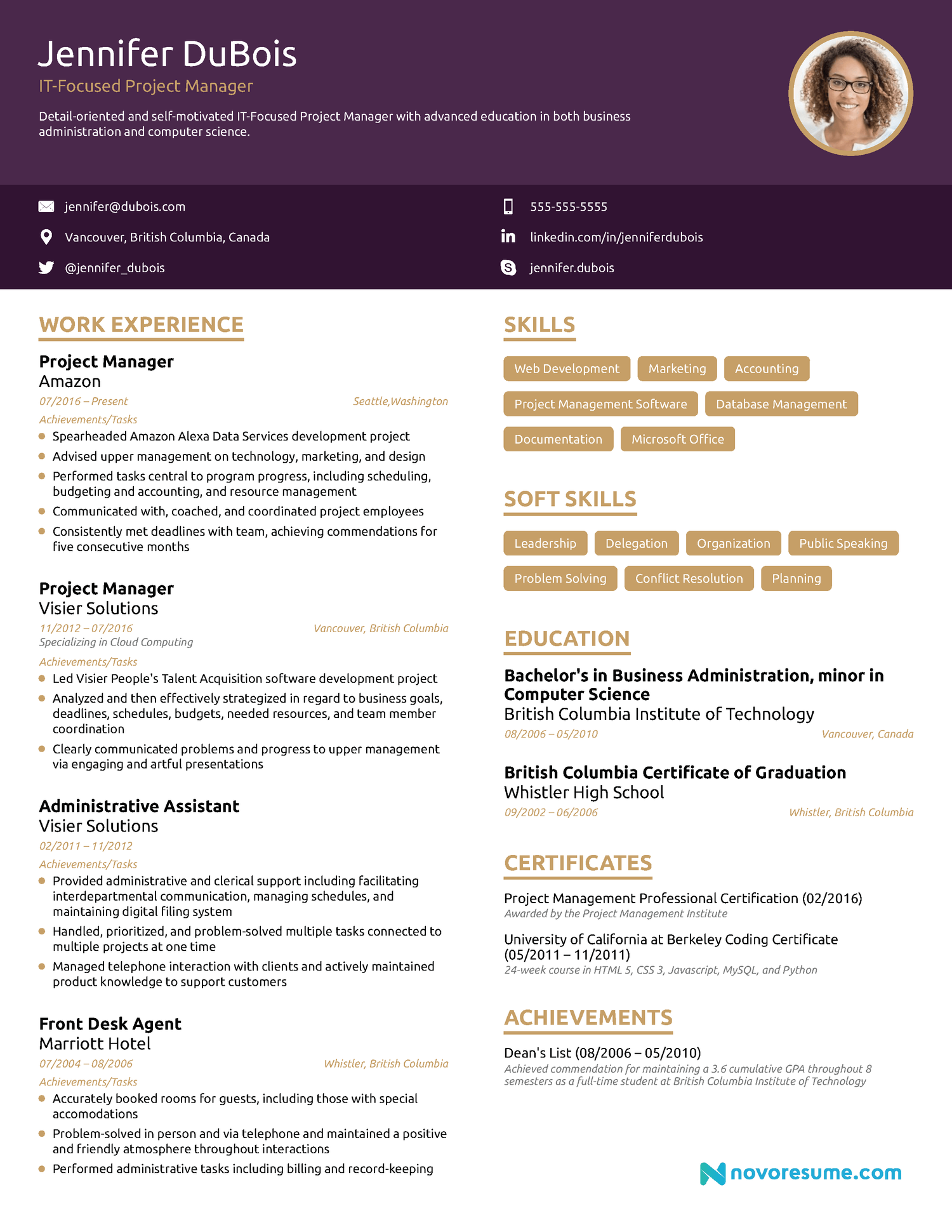
Project manager resumes have good chances to show industry expertise - given they hold the manager title - and highlight successful projects. Feel free to do both in your chronological resume, as shown above.
#7. Web Developer Chronological Resume
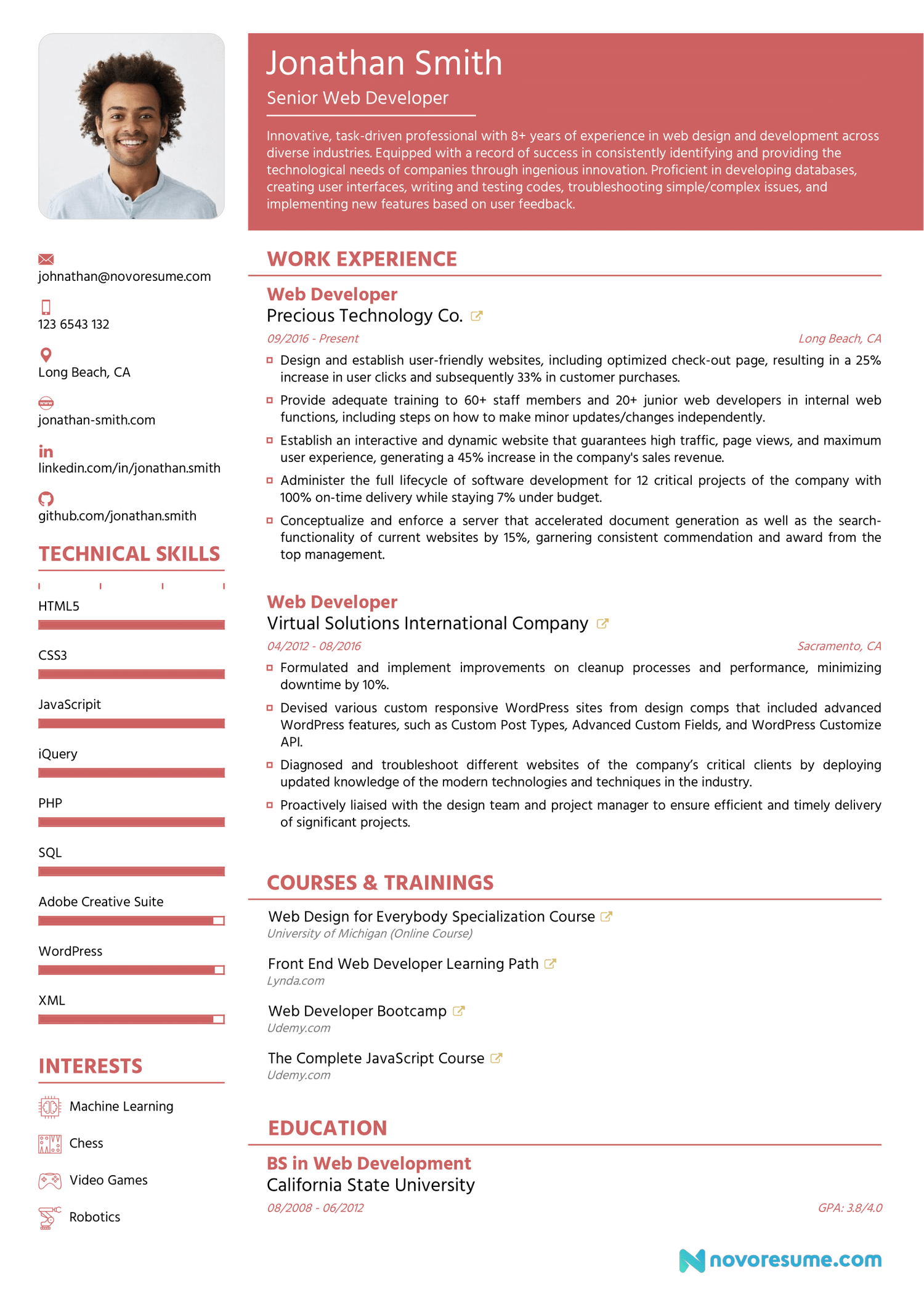
As you can see in the example, the candidate has chosen to place his courses and training above his education. When you have followed courses or have been trained in the exact field of work where you’re applying, it makes sense to rank the field-specific courses and training higher than your university education.
This article has more information on how to perfect your Web Developer Resume .
#8. Teacher Chronological Resume

This is another “special” example of a chronological resume. Right after the experience section, the candidate has listed their volunteering experience. Not normally the case, it makes sense here because the volunteering experience has been as a tutor - which is pretty much the same thing as a teacher in the teacher resume .
In cases when your volunteering experience is directly connected to the job you are applying for, feel free to list it under professional experience as well.
#9. Bar Manager Chronological Resume
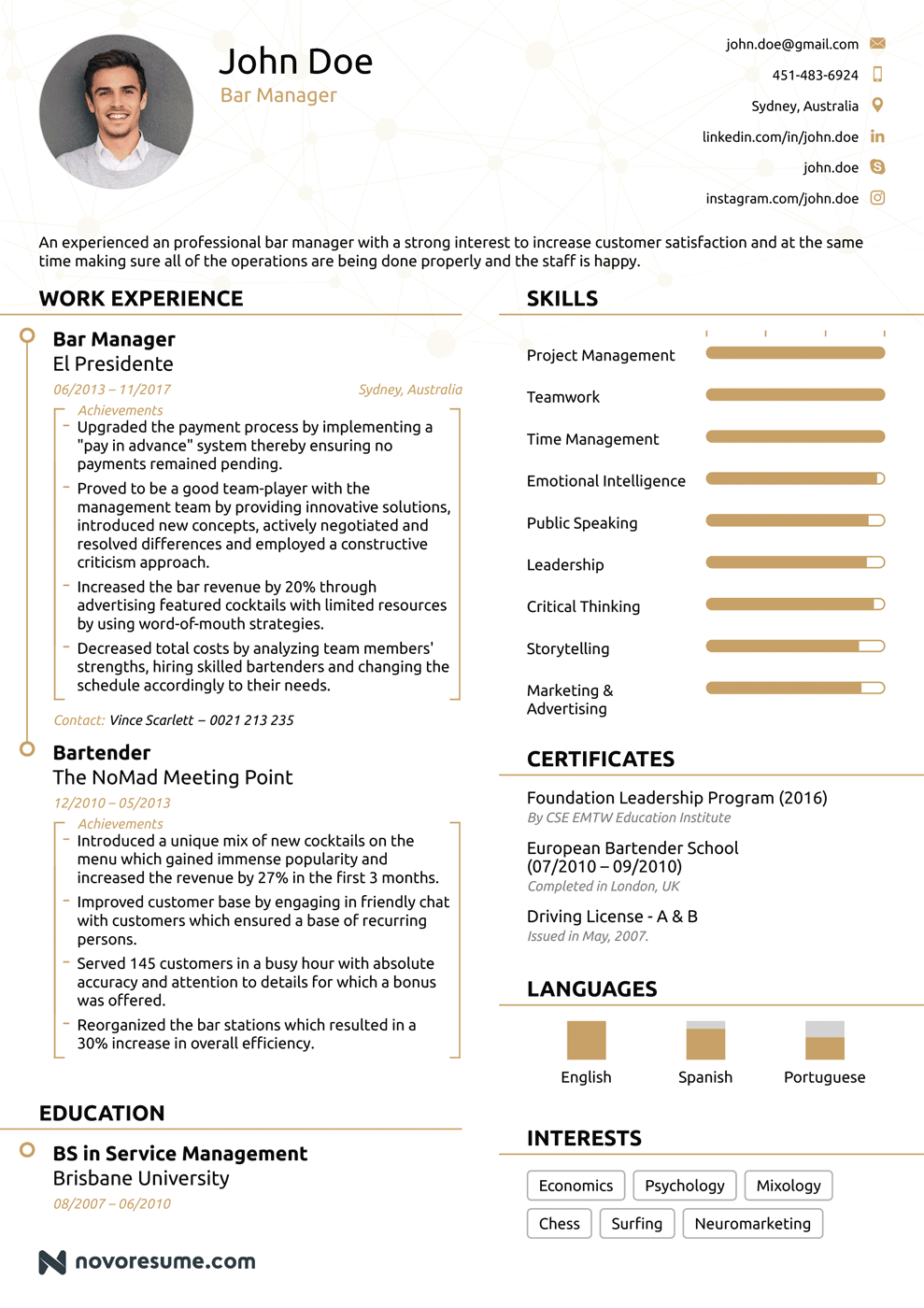
For more info on how to update your own bar manager chronological resume for 2024, this is the article for you.
#10. Human Resources Chronological Resume

The example says it all: the chronological resume does wonders showing the peak of your work experience first, and then going back to your professional history and skills. This article on the HR chronological resume has more tips on how to perfect it.
Discover More Resume Templates
- Combination Resume Templates
- Creative Resume Templates
- Functional Resume Templates
- Minimalistic Resume Templates
- High School Resume Templates
- One Page Resume Templates
- 2 Page Resume Templates
- Google Docs Resume Templates
- Word Resume Templates
Key Takeaways
And that’s a wrap!
Let’s do a quick recap of the main points covered in this article:
- The chronological resume - or reverse chronological - is a top choice among candidates with years of professional experience and a favorite among recruiters.
- The chronological resume focuses on your work experience, starting your current or most recent one, and following up with the rest - from most to least recent.
- Recent college graduates that want to use this format can - simply replace the work section with the education section, following the same reverse-chronological order.
- Save time and energy building the reverse chronological resume from scratch by using online resume builders , such as the one Novorésumé offers.

To provide a safer experience, the best content and great communication, we use cookies. Learn how we use them for non-authenticated users.
Resume builder
Reverse Chronological Order in a Resume
Here’s the thing. As a job seeker, the more your resume stands out, the better your chances of landing the job. And, as research shows, 92 percent of recruiters regard previous work experience as the leading hiring factor . That’s why listing your qualifications and work experience in reverse chronological order is the recruiter’s favorite approach to resume writing.
Want to know more about what a reverse chronological order resume is and when to use it? Keep reading, and you’ll find out.

Table of Contents
What Is Reverse Chronological Order?
Reverse chronological order describes events starting with the most recent and moves backwards in time . For resumes, it means highlighting your most recent job and qualifications first and listing your first job last.
The same goes for education, where the highest education level comes first followed by other schooling details.
Just like with other resume formats, a reverse chronological order resume follows certain rules. For starters, you must quantify your qualifications and list key achievements. Moreover, you need to be concise and use the best font for a resume for faster readability.
This resume format focuses on your work history and professional achievements and is the standard expected by most employers.
The reverse chronological order resume has three key parts:
- Relevancy : The format emphasizes to recruiters the relevance of your experience and job titles to determine if you’re a good fit for the advertised position.
- Recency : Since it lists your most recent job first, recruiters can easily see what experiences you’ve gained in the last five years.
- Longevity : The format makes it easy for employers to see how long you held previous positions. It shows your ability to commit and stay loyal to a company.
Reverse Chronological Resume Example
Here’s a sample resume written in reverse chronological order:
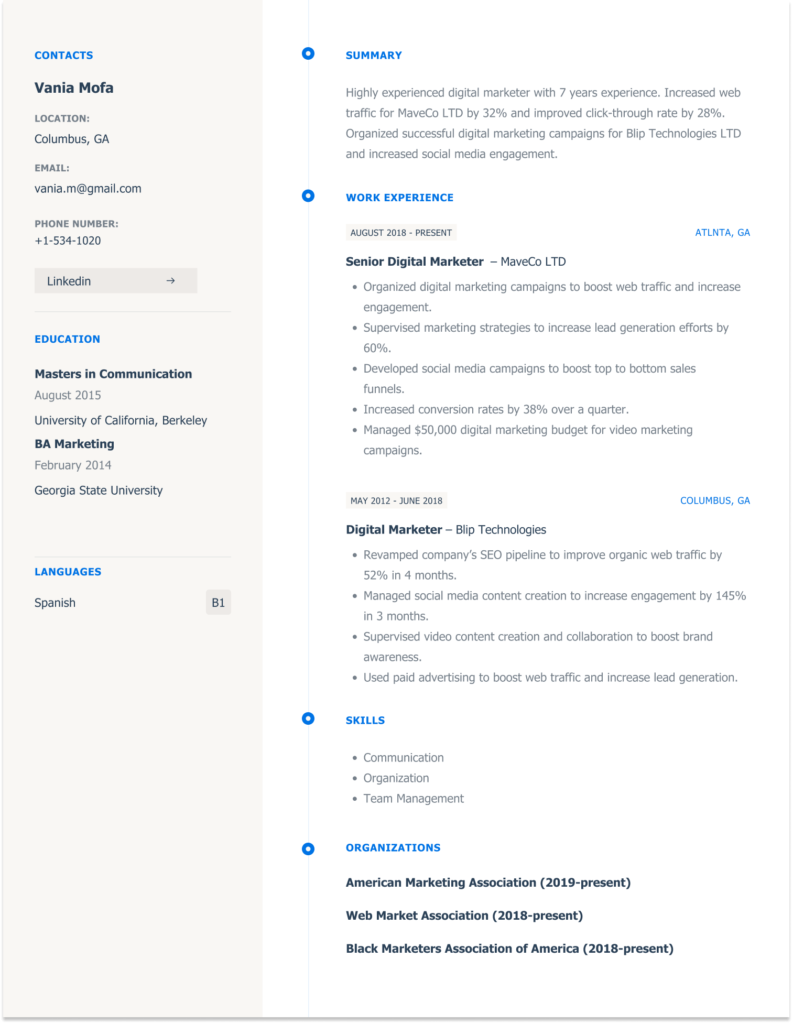
Why Is Reverse Chronological Order the Most Popular Resume Format?
This ordering system is considered the traditional resume format in all industries and professions. For that reason, recruiters and employers are more familiar with it, which makes it easier for them to analyze.
In addition, it seems logical to scan an applicant’s details starting with the current or recent job position and education history. For job seekers, the format makes it easy for them to highlight a consistent career path.
This can prove useful for those applying for a similar position as their previous job.
It Underscores Continuity
One of the top advantages of using reverse chronological order is that it links all your employment dates. A recruiter can immediately see a clear view of your career path, neatly organized in succession.
It also provides an effective way for job seekers to demonstrate their professional growth to potential employers.
Easy to Skim
A reverse chronological order requires that you format your resume in a certain order. You must start with your most recent job, followed by the one before it, and so on.
Additionally, you must provide your position, the company’s name, and the dates worked for each entry list. It’s this order that makes it easy to skim.
Easy for ATSs to Scan
Did you know that over 98 percent of Fortune 500 companies use Applicant Tracking Systems (ATS) in their hiring process? Normally, when there’s a corporate job opening, hundreds of applicants submit their resumes to try their luck.
This would make the work of recruiters an uphill task trying to sort through all those applications. ATS scans and scores these resumes to make it easier for recruiters to find those that meet the most important criteria defined in the job offer.
In other words, an applicant who uses this format stands a better chance of being picked compared to those who use a different format.
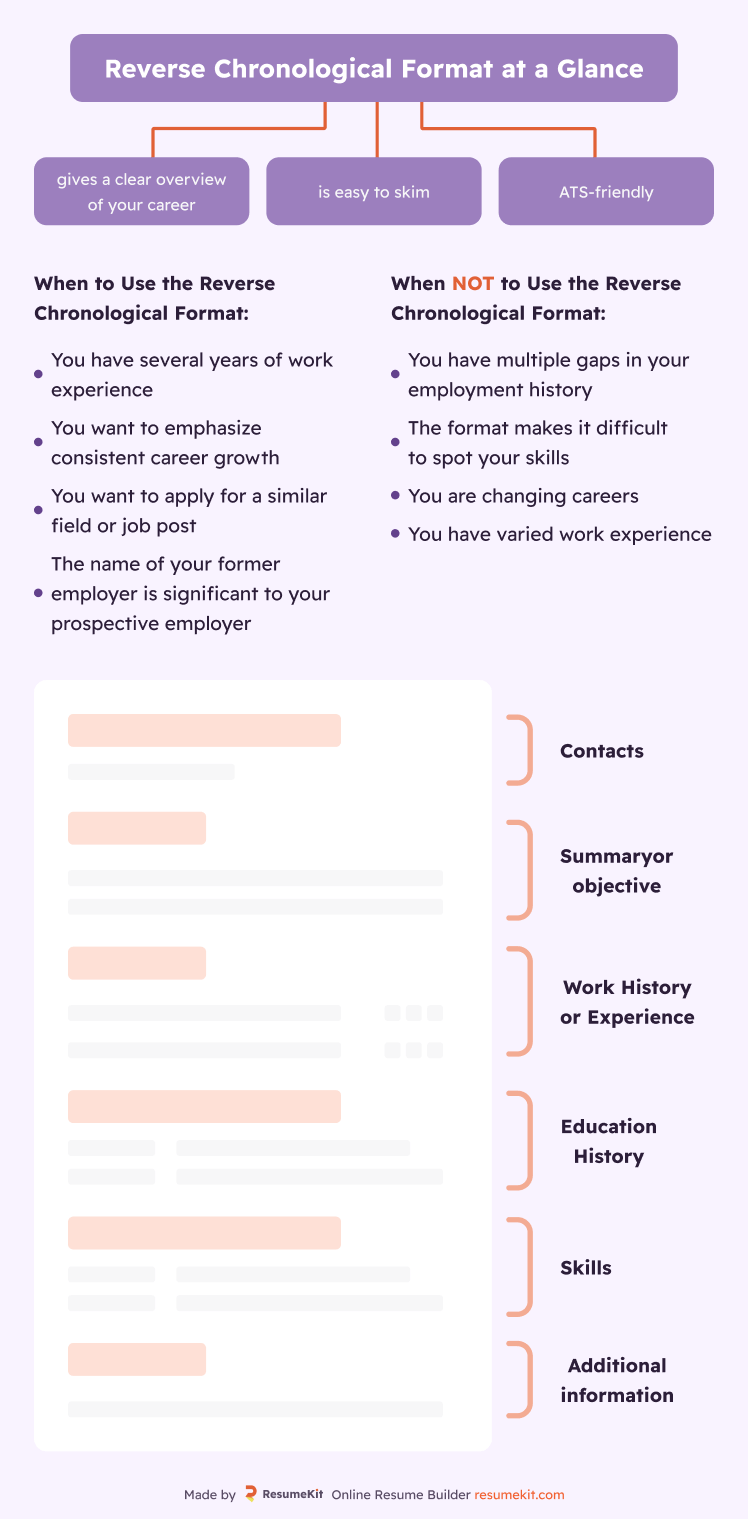
The Best Time to Use a Reverse Chronological Order Resume
The reverse chronological resume is ideal for job seekers who want recruiters to see the most relevant and important details about their work history . On top of that, this resume can be useful when:
- You have several years of work experience.
- You want to emphasize a consistent career growth and development, preferably in one industry, and each role you’ve held was more senior than the last.
- You want to apply for a similar field or job post to most of your work history.
- The name of your former employer is significant to your prospective employer.
When You Shouldn’t Use a Reverse Chronological Resume
With that in mind, there are times when a reverse chronological resume isn’t the best format to use. Here are instances when its wisest to consider a different type of resume:
- If you have multiple gaps in your employment history, the format calls attention to these interludes. Unless you have valid explanations, it’s wise to consider either the functional or combined resume formats.
- This format makes it difficult to spot your skills unless you’ve listed them in your most recent job.
- The format won’t favor you if you want to change careers . The employer will not see the relevance of your qualifications if you’re targeting a different position.
- Likewise, you’d want to consider other resume formats if you have heavily varied work experience .
Reverse Chronological Resume Writing Tips and Example
Now that you have a clear understanding of what a reverse chronological resume is, when to use it and when to avoid it, what’s next?
The juicy part – how to write your resume in reverse chronological order.
First things first: the layout
According to research by The Ladders , recruiters are most likely to notice resumes with the following characters:
- Clear and simple logical layouts
- Layouts that have bold job titles supported by bulleted lists of achievements
- An overview at the top
- Clear, eligible fonts
Typically, the reverse chronological resume comprises the following main sections
- Name, job title, and contact information
- Resume objective/summary
- Work history or experience
- Education history
- Skills and strengths
- Additional sections
Let’s take a detailed look at how you can make each section of your reverse chronological resume shine:
Name, Job Title, and Contact Information
This section might seem like a no-brainer, but you must be careful how you approach it. This is the header of your resume and will be the first thing employers see. So, you’d want to make sure it’s crafted correctly.
The details of this section include:
- Your job title
- Your location
- Your email address
- Links to your portfolio, blog, or social media profiles
Here’s a good example :
Gladys Dawson Nurse in Atlanta, GA (123) 456-899 | gdawson @ gmail.com www.linkedin.com/in/gladys-dawson
| : Gmail may be your best option when creating a professional email since it gives you access to the Google suite of networking tools. Plus, most companies use Google Workspace. |
Resume Objective/Summary
This is the first section of your resume that captures, in summary, what you can offer if hired. It focuses on previous experience (relevant to the position) and applies to candidates who have worked for at least two years. Use this section to highlight your skills and strengths.
We recommend to use some modern solutions to save some time: use AI resume builder to write autogenerated objective and summary for your profession.
Work History or Experience
In this section, you want to be as precise and accurate as possible. False or erroneous information is something employers don’t tolerate. This is just one of many resume mistakes that can be instant deal breakers for employers.
Here are tips to make the most of your professional experience in a resume:
- Start with the most recent position at the top and follow it up with the previous one. After all, you’re following a reverse chronological order.
- Indicate the dates worked, the company’s name, and the job title for each position listed. If necessary, add the company’s location.
- Make your work scannable by including at least three bullet points . They should be short and simple sentences describing your responsibilities and any quantifiable achievements. Start each bullet point with strong action words, such as achieved, boosted, delegated, etc.
- Create a special subsection for key achievements .
- Demonstrate only the experience that’s relevant to the position you’re applying for.
Read more about how to write good resume bullet points .
Education History
If you don’t have much experience for the job position but have the qualifications to show for it, you can start with the education section. Follow this up with the work experience section.
Otherwise, the reverse chronological resume favors the experience section more than any other element. If you have years of work experience and want to highlight all of them, the education section doesn’t have to be extensive.
With this format, you only need to include five key pieces of information . These are:
- University, College, or School
- Your highest level of education
- Year of graduation
- The school’s location
- Area of specialization (study)
You can include any relevant academic achievements or experiences that you feel are beneficial to the job position.
Employers will be interested to see the skills you’re good at. Consider listing around six skills , making them short and simple. More importantly, the skills should be relevant to the position you’re applying for.
You should list both hard and soft skills . Hard skills comprise those that require technical or job-related knowledge, for example, coding and analytical skills.
Soft skills can be personal qualities or traits that help you get along with others. They are commonly known as “people skills.”
A CareerBuilder survey shows that 62 percent of job descriptions list management and leadership as desired soft skills. Others include interpersonal skills and innovation and creativity skills.
Additional Sections
There’s nothing wrong with wanting to earn extra points from a potential employer. The additional sections of a resume allow you to emphasize other relevant facts that make you stand out from the crowd.
Just remember to be mindful of the formatting. You don’t want to draw attention away from the work experience section. Another thing to keep in mind is to only add parts that will boost your chances of employment.
Here are some ideas:
- Certifications or extra training, such as dropshipping or digital marketing courses
- Unpaid experiences, like volunteer work
- Awards and achievements, e.g., Employee of the Month Award
- Languages. List languages you can write and speak proficiently
- Interests and hobbies
Avoid cramming too much information into this section. You want to ensure a good visual flow of information that’s scannable.
| : of hiring managers spend less than 30 seconds looking at resumes. So, you’d want yours to be as attention-grabbing as possible. |
What Are the Top Resume Formats?
Applying for jobs is no mean easy. To come out on top, you must be creative and pick the right resume format based on the job you’re applying for.
Generally, there are three main resume formats :
- Reverse-chronological : As we mentioned earlier, the reverse chronological resume format is the most popular. It lists your work history in reverse order, starting with your current or most recent job at the top.
- Functional (Skill-based) : This format focuses more on relevant skills than work experience. It highlights what you’re good at (skills and abilities) and takes the pressure off of your employment history. It’s ideal for graduates who have the skills necessary for the job but not much work experience.
- Combination (Hybrid) : This format blends the resume elements of a chronological and functional resume. It emphasizes both skills and work history.
| : Learn , no matter the format you choose. |
Key Takeaways
Armed with these fundamental principles of creating a reverse chronological resume, you shouldn’t have a problem writing one yourself. Remember, stick to simple fonts, use bold text to show prominence, focus on your achievements, and do not lie or mislead recruiters.
Leave a Reply Cancel reply
Your email address will not be published. Required fields are marked *
Save my name, email, and website in this browser for the next time I comment.
Reverse Chronological Resume Templates
If you’ve ever written a resume before, you may already know about the reverse chronological resume format. But what does a reverse chronological resume actually involve? Let's explore.
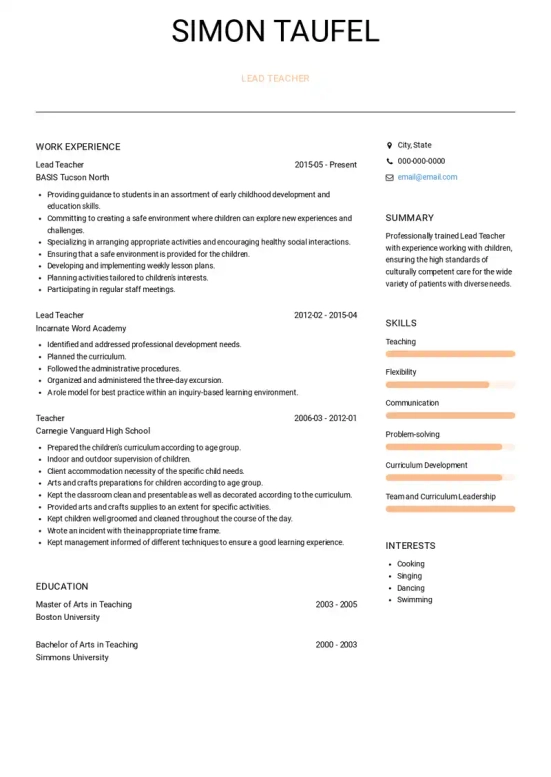
If you’ve ever written a resume before, you may already know about the reverse chronological resume format. It’s the most popular resume format out there, and it’s a classic for a reason. With a reverse chronological resume, you can prioritize your most recent work experience, giving hiring managers a clear sense of where you are in your career.
But what does a reverse chronological resume actually involve? Should you always rely on this tried and tested format, or are there times when it’s better to take another approach? And do you need a particular resume template to make the most of the reverse chronological approach?
If you’ve ever asked yourself any of these questions, look no further! We’ve put together a comprehensive guide to the reverse chronological resume format, so you can get the most out of it when it’s time to look for a job. Read on, and we’ll give you all the information you need to know!
On this page, we’ll cover the following points:
- What a reverse chronological resume actually is
- How to build your reverse chronological resume
- When to use the reverse chronological resume format
- Some of our favorite reverse chronological resume templates
What is a Reverse Chronological Resume?
A reverse chronological resume is a resume that organizes the work experience section in reverse chronological format. That means it lists your most recent work experience first—then works backwards, in the same order, through your work history.
If this sounds like the standard approach to writing a resume, that’s because it is! The reverse chronological resume format is by far the most popular way to arrange a resume. It isn’t the only way to do it, but it’s certainly common enough to be the default approach.
That’s because most employers consider recent work experience to be the most important factor they consider when hiring. A reverse chronological resume puts your most recent work experience at the forefront of your resume. It makes it easy for hiring managers to find what they’re looking for—and since most hiring managers are extremely short on time, that will give you a real advantage in its own right.
It’s also worth remembering that many companies use ATS (applicant tracking software) to sort qualified applicants from unqualified applicants. This happens right at the start of the hiring process, usually before a real person has even looked at your resume. Reverse chronological resumes are easy for ATS software to parse—meaning that a reverse chronological resume might give you an edge in getting through that crucial first stage.
The reverse chronological resume format is versatile, widely recognized, and easy for both humans and software to read and understand. Where other resume formats tend to have very specific applications, the reverse chronological format is a great approach to take in most circumstances. If you’re not sure which resume format to use, the odds are good that this format will work well for you!
How to Make a Reverse Chronological Resume
As you might expect, it’s simple to make a reverse chronological resume! You just need to make sure you have your approximate dates of employment in all your recent roles. That way, you’ll have a much easier time sorting them into the right order.
Like any resume, your reverse chronological resume should contain all of the following sections:
- Your name and contact information
- A resume summary (and objective, if you have limited prior experience)
- Your recent work experience
- Your education, including any certifications or licenses
- Your skills
These sections can, within reason, appear in any order. That said, it’s standard to feature your name and contact information and your resume summary at the very beginning of your resume. And unless you’re applying for your first job, your work experience will usually be the most important section of your resume—so after those two elements, your work experience should appear next.
When writing a reverse chronological work experience section, you need to list your recent roles in order, starting with the most recent and working backwards. When listing each role, you should include all of the following information:
- The name of the company where you worked
- Your job title
- Your employment dates (it’s usually fine to list the month and year when you started and the month and year when you finished)
- A bullet-pointed list of your most relevant achievements and responsibilities within the role
As always, you should tailor this section to the requirements of the job description for the role you want. If you need prior customer service experience to be considered for your new role, make sure you mention your prior customer service experience when writing about your recent employment! And wherever possible, you should try to quantify that experience with concrete, verifiable achievements—things like statistics, sales figures and performance indicators will make your resume much more credible.
You should also make sure that all of your employment history listings are formatted in the same way. That consistency will make for a more visually appealing resume, and will make sure you look as professional as possible. Choosing the right resume template can help you with that, and we’ll list some of our favorite reverse chronological resume templates later in this post.
How to Use a Reverse Chronological Resume
The reverse chronological resume can be a great asset in a range of job search situations. But when is it a particularly good idea to use this resume format? And most importantly, when should you consider using a different format instead?
The reverse chronological format is ideal in two particular situations:
- You have a consistent employment history, without any substantial gaps
- You have worked in the same industry (or similar industries) throughout your career
Reverse Chronological Resume and Career Gaps
Because a reverse chronological resume gives hiring managers a comprehensive overview of your career history, it doesn’t leave you anywhere to hide any gaps or career breaks. If you’ve taken an extended period of time off from work for any reason, this could put you at a slight disadvantage if you use the reverse chronological resume format.
It’s worth noting that that doesn’t have to be a dealbreaker! If you took a few years off to raise a child, care for a loved one, or pursue further education, you may be able to list that career break as part of your work history. That way, the gap in your work history will be accounted for right away, and won’t lead to any potentially awkward questions if you get to interview.
But if you’re worried about calling undue attention to a career gap, you may benefit from using a different resume format. A functional resume or combination resume format will give you more scope to gloss over a career break, since they are less focused on providing a chronological recounting of your work history.
Reverse Chronological Resume and Career Changes
Likewise, if you’re making a big career change, you may not want to focus so much on a reverse chronological listing of your work experience. That’s because your work experience may not be relevant to the job you actually want. In this case, a reverse chronological resume format might lure you into including a lot of information that may not matter much to a hiring manager!
In that situation, focusing on your skills will give hiring managers a clearer picture of what you’re capable of. A functional resume, which puts the spotlight on your skills and how you have applied them in the past, may give you a bigger advantage.
Best Industries for a Reverse Chronological Resume
We’ve talked about the situations when a reverse chronological resume may not work well for you. But what about the industries where it can particularly shine?
As we’ve discussed, reverse chronological resumes are widely-used and widely-understood. The only real circumstances in which a reverse chronological resume won’t work for you are the two we’ve explained above. That means that, provided you don’t have any career gaps you’d like to gloss over and you aren’t making a big career change, you can use a reverse chronological resume format in just about any industry.
But there are certain industries where a reverse chronological format can really shine. If you’re looking for work in a more conservative industry, where employers may be suspicious of a less conventional resume format, the reverse chronological format should be your first choice. In that situation, applying with a reverse chronological resume will show that you understand professional norms and standards—and most importantly, that you are prepared to adhere to them.
Here are some industries where a reverse chronological resume format will serve you especially well:
- Administration
- Manufacturing
- Pharmaceuticals
That’s not to say that you can’t use a reverse chronological resume in less traditional workplaces or industries! Creative fields like design, marketing and media will still understand and appreciate a reverse chronological resume. So will cutting-edge workplaces like start-ups and tech companies, which have a reputation for experimenting with new ideas before other companies follow suit.
But those companies may be more receptive to other resume formats than the industries listed above. When applying for a job in a more traditional industry, it’s smart to stick to what works—and that’s the reverse chronological resume.
What Type of Resume Offers a Reverse Chronological Order?
At VisualCV, we believe we offer some of the best resume templates on the internet. But which one should you choose for your reverse chronological resume?
The good news is that there’s no wrong answer here! All of our templates can be adapted to suit a reverse chronological resume order. What’s more, they’re all guaranteed to be ATS-compatible, so whichever template you choose will work seamlessly with ATS software regardless of its format.
To get you started in choosing the right template for you, we’ve listed some of our favorite resume templates below. Take a look and see which one you like best!
This streamlined, elegant template offers a great way to format your reverse chronological work history section. Pops of color call attention to your past employers and employment dates, so hiring managers can understand at a glance what they’re reading. It’s readable, visually engaging, and stylish enough to pass muster at any type of company—so wherever you take Arya, it will have your back.
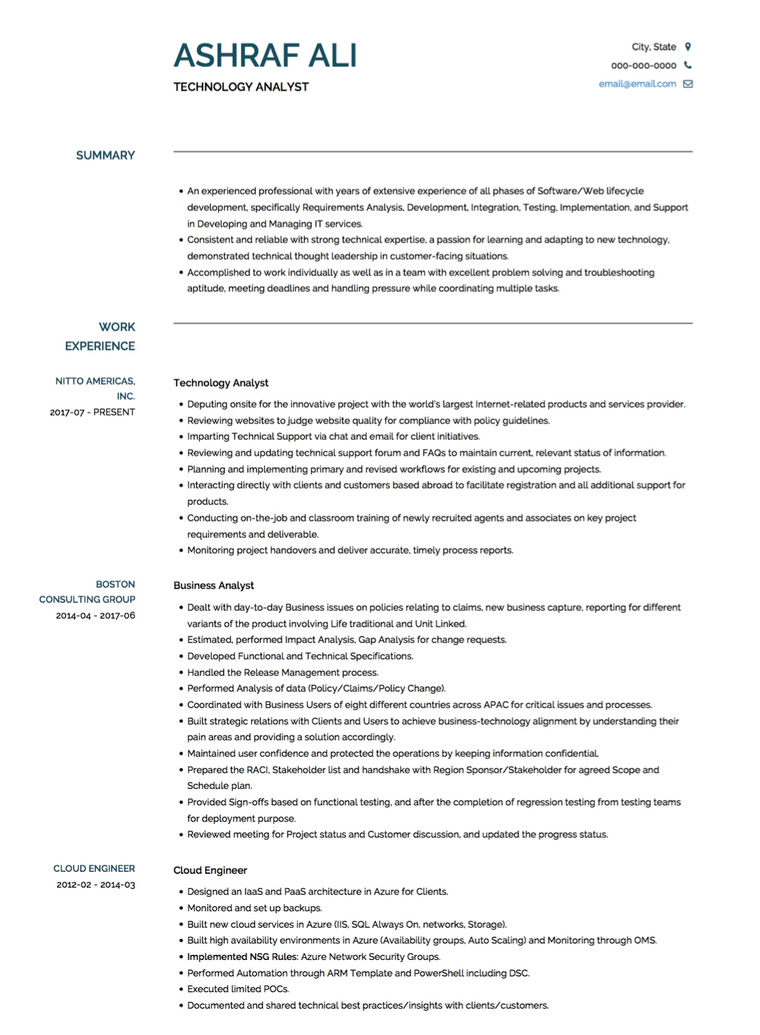
Are you applying for a company that could be put off by the bells and whistles of more creative resume templates? Or do you just want to be 100% confident that your resume will make it through an ATS software screening? The ATS resume template is simple, sleek and traditional in every sense—which makes it perfect for a reverse chronological resume format.
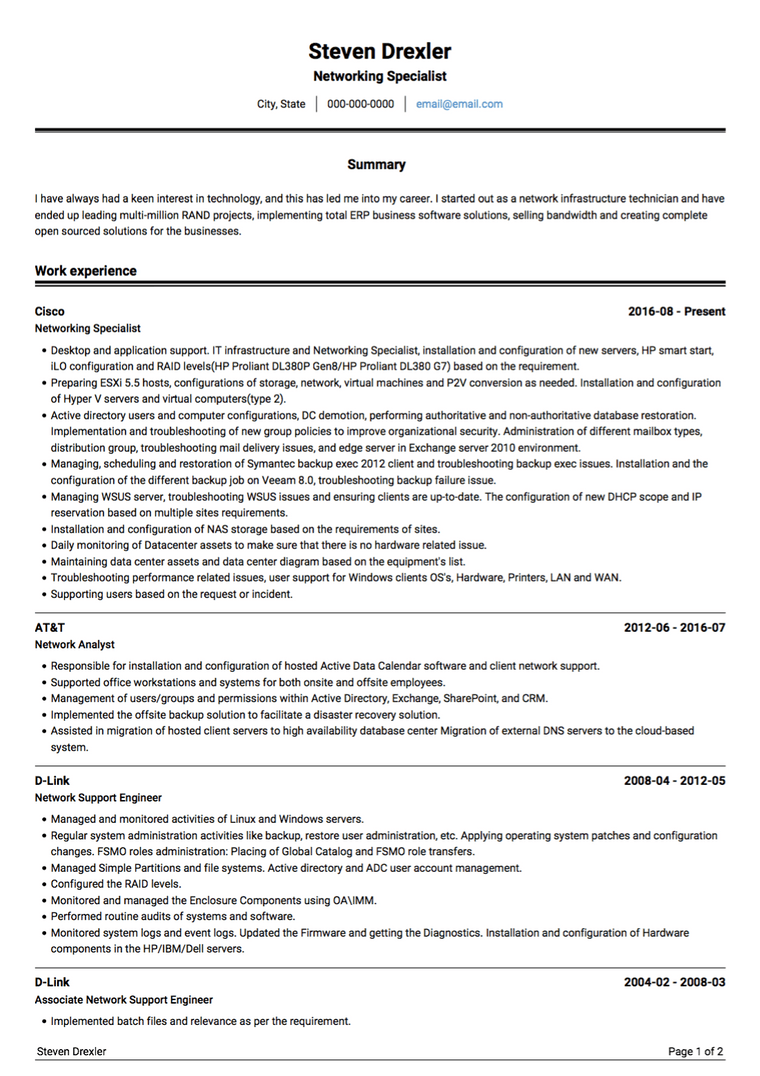
The Corporate template is built for the world of business, featuring a streamlined two-column layout and classic, readable fonts. Within the work history section, it calls attention to the employment dates, so it’s easy for hiring managers to understand the reverse chronological format. If you’re applying for a job in a traditional industry and don’t want your resume to skew too creative in its design, this is the template for you.
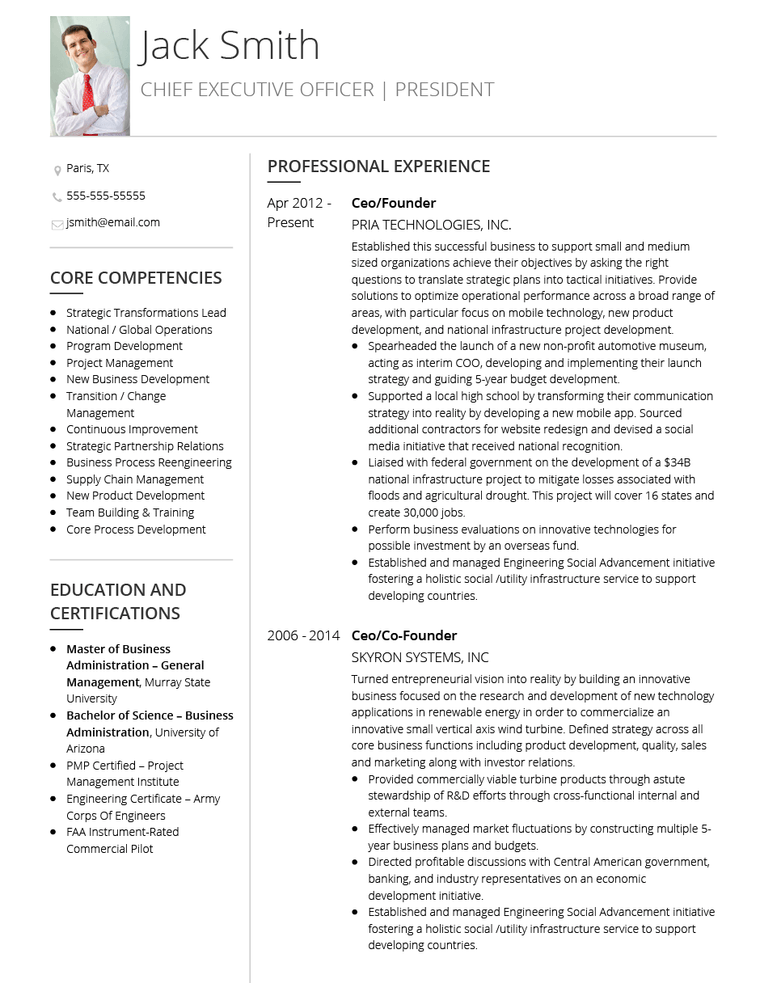
The Monte template offers the best of both worlds, striking an elegant compromise between its traditional layout and its more creative font and color choices. It’s designed for a reverse chronological format, with employment and education dates set apart for ease of reading. For applicants looking to add a touch of personality to a classic resume format, this template is the way to go.
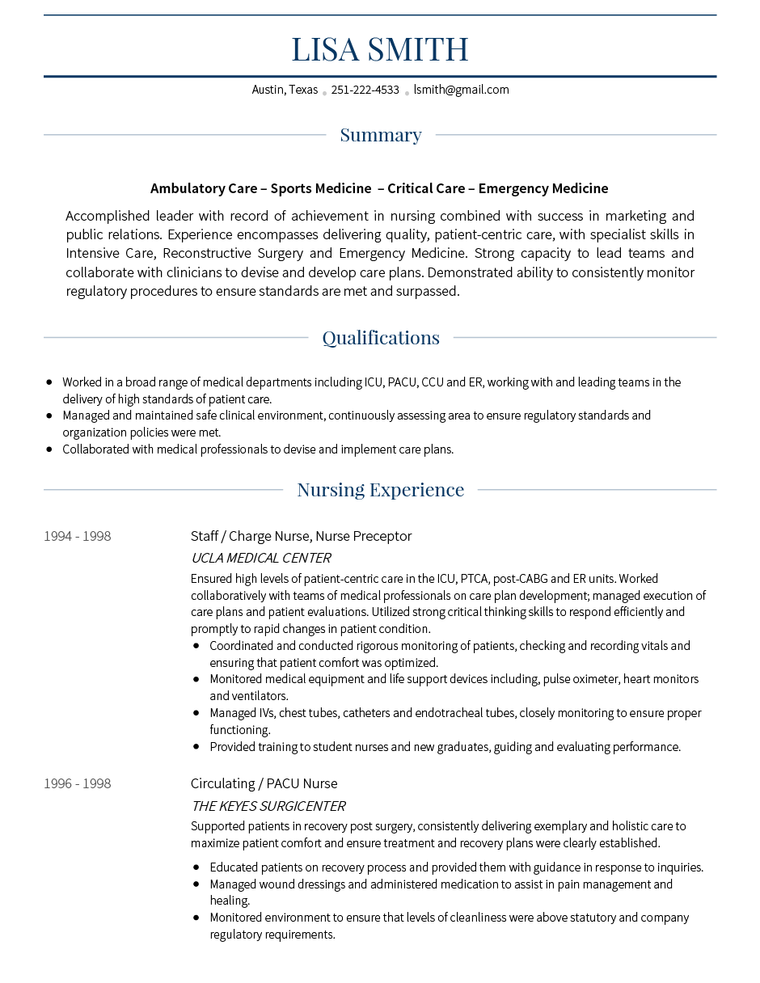
This two-column resume template uses pops of color smartly, calling attention to key details like employment dates throughout. While its formatting choices are bold and eye-catching, it uses them sparingly enough to avoid seeming unprofessional or chaotic. This template is particularly great for candidates looking for a one-page resume—the two-column layout allows you to fit more information onto a page, without ever compromising on style.
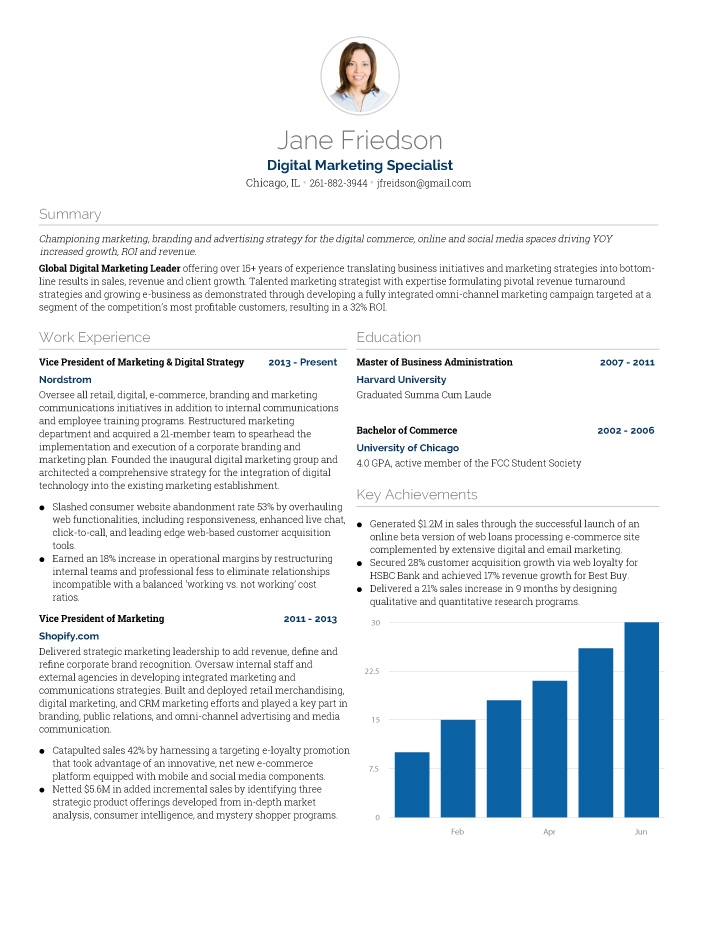
Copyright © 2024 Workstory Inc.
Select Your Language:
Protect your data
This site uses cookies and related technologies for site operation, and analytics as described in our Privacy Policy . You may choose to consent to our use of these technologies, reject non-essential technologies, or further manage your preferences.
- Resume and Cover Letter
- How to Use a Reverse...
How to Use a Reverse Chronological Resume Format
10 min read · Updated on February 07, 2024

Everything you need to know about writing the most common resume format
For most professionals, a chronological resume is the best format to capture skills, experience, and achievements. That's because this resume format focuses on the employment history section, which gives plenty of space to explain the candidate's career trajectory.
The reverse-chronological resume format is also what hiring managers prefer to see , meaning that an alternate structure could even decrease your chances of landing the job.
To keep that from happening to you, let's explore how to use a reverse-chronological resume format. You'll also find a few guiding examples that can help you to produce a perfect example of the most popular resume out there.
What is a chronological resume?
The chronological resume is a format that focuses on the employment history section where work experience is listed. The main idea is that you start with your most recent or current position and work backward through all your relevant experience of the past 10 years.
NOTE: This structure is sometimes called the “reverse-chronological resume format.”
It's been said that past behavior is the most reliable predictor of future outcomes. Therefore, prospective employers rely on your career accomplishments to get an idea of what you can do for them. That's part of what makes the reverse-chronological resume format so popular.
When hiring managers can quickly digest what you've done in the past, they are able to get a feel for whether you'll be the right candidate for their team. By focusing your career history on the most recent experiences and working backward for about 10 years, you provide the most up-to-date and accurate representation of what you bring to the table.
It's critical to note that the structure of your reverse-chronological resume is important, too. How the information is laid out on the page will aid the hiring manager – who's spending mere seconds glancing at it – to easily find the information about your career history they want.
How to structure a chronological resume
Your chronological resume will contain at least six sections with relevant headers. Here's an outline of what you should include in your chronological resume:
Contact information
You want the hiring manager to contact you for an interview, right? Well, here's the place to make sure they have the details they need to do just that. Include your name (it doesn't have to be your full legal name – just use whatever you go by), location, phone number, and email address. You can also add links to your LinkedIn profile (if it's been properly optimized) and any online portfolios you may have
The headline grabs the reader's attention. Write a one-line blurb that contains the title of the job found in the job description, along with a couple of relevant keywords that will help you to stand out from the crowd.
A summary or professional profile
Your professional summary is a three to five-sentence paragraph that outlines the major events of your career. Start with something that mirrors the title on the job description and match it up with the hard and soft skills you have. Throw in at least one achievement.
This is the place for a bulleted list of skills. Include 9-12 skills that you have that will show the hiring manager you have what it takes to get the job done. Use the same language and keywords you find in the job description to ensure that your resume makes it past the ATS .
Work experience or employment history
Now you've come to the nitty-gritty part of your resume – what you've done, when, and where. Keep in mind that hiring managers will look to your past accomplishments to see what you have to bring to their team. It may be tempting to dump everything you've ever done , but relevancy is critical.
Let's take a closer look at how to write this section.
Always list the name of the company you work for first. This is important because if you have a company where you held multiple roles, you can stack the roles to show progression. You need the following information as a sub-heading:
Employer name
Dates worked
Then, add 4-5 bullet points to discuss various aspects of your time in the position. You can focus on topics like:
Projects or tasks you completed
Skills you used
Awards and achievements
Numbers and statistics that quantify your successes
Make sure to list these entries starting with your most recent or current job and working backward, as this is a fundamental component of the reverse-chronological resume format.
For your education, you can (and should) include degrees and the colleges you've attended. However, don't forget about things like professional development classes, certifications, and licenses. Spell out acronyms and omit your graduation dates. Again, this section should be presented in reverse-chronological format.
Additional sections like awards, hobbies, or languages
Sometimes, there are things you've done outside of the regular work day that are also important to securing a new job. You can create additional sections on your resume for things like public speaking, special projects, and awards. Just remember, if you're adding it to your reverse-chronological resume, it needs to be relevant to the hiring manager who will receive it.
Tips on when to use a reverse-chronological resume format
The chronological resume is considered the standard resume format because it suits the widest range of professionals, including people in healthcare, IT, law, HR, business, and education. It's especially useful if you've enjoyed a progressive career with advancements through promotions and new jobs.
The chronological resume is less suitable for creative or independent professions, where gig work and short-term contracts are part of the career path. In those cases, alternative resume formats like functional or hybrid models may be more suitable.
Expert Tip: You should try to use the hybrid format instead of the functional format. There' a bit of a stigma associated with using the functional resume format .
How to use reverse-chronological resume format
Now that you know what a chronological resume is, what the outline looks like, and who should use it, let's dig into the actual writing part.
The format of your chronological resume is almost as important as the writing, because a clean and organized layout is one of the best ways to show that you're a professional and motivated candidate.
Make sure to use bold or italics to highlight the key information within your resume, including the employment history section.
Examples of chronological resumes
To get a sense of what goes into a great chronological resume, let's look at the employment history section for a customer service representative:
Customer Service Representative, Fort Worth, TX
August 2020 - present
Handled customer calls and responded to queries about services, product malfunctions, promotions, and billing
Worked to address all customer concerns in a timely and effective manner
Calmly handled 200+ calls each day
Developed successful tactics to upsell products and services to customers
Piloted a feedback program that resulted in a 15% increase in branch sales
Here's an option for a Server:
Rooster Bar & Grill, Boston
Lead Server
June 2018 - August 2022
Managed a staff of 15 as the Lead Server at a high-end downtown restaurant
Achieved promotion to Lead Server six months after joining the team
Upsold wine pairing suggestions to customers, based on preferences
Memorized ingredients and allergens on a menu of 30+ dishes
Performed bartending responsibilities during holiday weekends and special events
Check out this example for a Sales Associate:
ABC Pet Shop, Durham, NC
Sales Associate
September 2021 - present
Maintained a clean shop environment and neat product displays
Gained recognition for reliability and zero absence work record
Fed animals and made sure they had access to fresh water
Answered customer questions and referred to other departments
Helped customers find products that best fit the needs of their pet
Maintained accurate work logs and reported inconsistencies
Chronological resume template
If you're looking for a little more help creating a flawless chronological resume, here's a template that can allow you to quickly plug in your information and be assured of the right format. These are the essential sections, but you may find hobbies, memberships, or other additional sections to be necessary on your resume.
Header information
Your name & job title
Phone number
Email address
LinkedIn profile
Professional summary
Add a paragraph explaining who you are, what you do, your industry and your area of expertise. Show off your soft and hard skills and give an example of a past accomplishment to show how you can add value to a new employer.
Employment history
Employer name and job title
Dates worked and location
Main duties and responsibilities
A key skill demonstrated
Measurable achievement #1
Measurable achievement #2
Degree name, school
Dates attended, location
Optional bullet point for GPA
Optional bullet point for leadership positions
How to adapt the reverse-chronological resume format for students
Whenever possible, first-time job seekers should aim to create a reverse-chronological resume. However, they may have to resort to an alternative if they lack experience.
Trying to land your first job as a student or recent graduate can feel daunting, especially when you don't have much experience to show. While it may be tempting to try out another style of resume, the reverse-chronological resume format can actually be adapted to the needs of students with little effort.
If you don't have any traditional employment to show, simply rename the section “Experience.” This allows you to include any volunteer positions, hobbies, side jobs, internships, or school activities that can serve as your work history for the time being. You may also wish to move the Education section above the Experience section, as it's likely to be more relevant to your current aspirations.
The rest of the rules of the chronological resume apply, including listing your positions from most recent to oldest and making bold section headings. Here's an example:
Eagle Scout, Boy Scouts of America
May 2022- present, Richmond
Awarded the highest honor for scouts after passing a lengthy review process
Planned and completed the final project involving new traffic patterns at deadly intersections
Reviewed accident records and worked with city officials to develop a crosswalk plan
Worked to educate the local community on safe pedestrian practices
Treasurer, National Math Honor Society, Arcs High School
September 2021 - May 2022, Richmond
Managed bookkeeping and revenue for the high school chapter of a national organization
Tracked payments and expenses and created reports for the Club Supervisor
Worked to eliminate unnecessary spending, resulting in 20% additional profit for the club
Organized four fundraisers that brought in $10,000 over the course of a year
Petsitter, Private client
June 2020 - present, Richmond area
Supervised and took care of three dogs for a neighbor during a two-week vacation
Took dogs on walks twice a day and fed them according to owner's instructions
Reported issues and behavior changes to the owner and adapted accordingly
Land your dream job
With these tips, templates, and adaptable examples, you're on your way to creating a great chronological resume, wowing the socks off a hiring manager, and landing your dream job.
Find more resume writing advice in our related articles below, or upload your resume for a free resume review from our experts!
This article was originally written by Anna Muckerman and has been updated by Marsha Hebert.
Recommended reading:
How to Check if My Resume is ATS-Friendly
What is a Resume? It's Much More Than You Think
Resume Builders Versus Resume Writing Services: Which Should You Choose?
Related Articles:
How to Maximize Your Resume Action Words to Wow the Employer
Resume Spelling and Accent Explained
Guide to Writing a Great Resume with No Work Experience
See how your resume stacks up.
Career Advice Newsletter
Our experts gather the best career & resume tips weekly. Delivered weekly, always free.
Thanks! Career advice is on its way.
Share this article:
Let's stay in touch.
Subscribe today to get job tips and career advice that will come in handy.
Your information is secure. Please read our privacy policy for more information.
WTO / Human Resource / Resumes / Reverse Chronological Resume Explained (Free Templates)
Reverse Chronological Resume Explained (Free Templates)
Your resume should grab an employer’s attention when you are looking for work and make it easy for them to scan through the most important details. A reverse chronological resume is an effective way to present a candidate’s work history in a clear and concise format, making it easier for employers to assess their qualifications and make hiring decisions.
However, if you decide to use this format, you must learn how to create it correctly. This article will provide information about the following:
- What is the reverse chronological format?
- Key sections of the resume
- Pros and cons of using this resume format
What is the Reverse Chronological Resume Format?
A reverse chronological format displays your academic and professional experiences in reverse-chronological order. It indicates that the document lists all of your previous jobs in chronological order, beginning with the most recent one you held.
The last entry on the list will be your first job. This format has become very popular and is the most common type of resume people use, and people in hiring departments are used to this format.
Besides that, employers can easily see someone’s professional development or career progression, as it provides a clear timeline. This format is more contextual to the position you are applying for, which makes a great impression on recruiters.
When Should I Use this Format?
Even though you can use the chronological resume in different situations, there are some scenarios when you should choose another option.
When to use chronological resume:
- When you have many years of professional experience in different companies.
- When you have a stable career progression with a steady path.
- If you do not have gaps in your career.
- When you want to highlight your current position.
When to avoid chronological resume:
- When you have no or little work experience.
- If you want to highlight some of the earlier positions and experiences in your career.
- When you have any gaps in your work experience.
Essential Sections of a Chronological Resume
The information you add to your resume is the most critical aspect of the document, which is why this article will cover all the main sections of a resume .
You can also add additional information, but here is the structure that should be the core of your document:
Your full name and current job title
The first part of any document is the header, which should include your full name and current job title. Although there are many differing opinions on the subject, writing the title of the position you are applying for will only make you appear overconfident.
Contact information
You must add basic contact information underneath the heading, including an address, email, phone number, or social media links. Ensure all the information is professional and current so that the hiring manager can easily contact you and discuss the position.
Personal statement
The personal statement is an introduction that gives recruiters a glimpse into your best qualities and suitability for the job opening. A personal statement can either be a summary or an objective statement. A resume summary showcases previous experience, making it great for people with at least two years of experience. On the other hand, a resume objective focuses on skills, making it ideal for people without work experience.
Work experience section
This section is the core of a chronological resume . It should contain detailed information about the positions you held in a structured and chronological manner.
Here are some of the rules you should follow when writing about your work experience :
- Only include professional experience relevant to the position you are applying for.
- Start with your latest (current) position and continue by listing your previous positions in reverse chronological order.
- Include the job title, company name, dates of employment, and other relevant information for each position.
- Make the section easy to read and use bullet points. Use an average of five bullets per position.
- Include action verbs in your bullet points, like managed, organized, led, aligned, hired, cultivated, directed, etc.
- Focus primarily on duties and achievements instead of responsibilities.
- Demonstrate the impact of your work.
Education section
Like the work experience section, you should start with the latest educational achievements. Depending on your level of work experience, your education section can be longer or shorter.
If you have more than a couple of years of work experience, list only essential information, like:
- Information about the subject you majored in
- Year of graduation
- Name of Universities
In case you do not have two or more years of experience, you can include more information, such as:
- The minor you studied
- Student exchange programs attended
- College honors

Skills section
Every type of resume needs to include your skills. You can list them by relevance or alphabetically; both options are good. Naturally, all the skills you list should be relevant to the position.
Make a list of your soft and hard skills. Take the time to read the job description to see what the employer is looking for. Then you must compare your list of skills with the skills required by the employer in the job description. It is essential to include all the skills required in the job description.
Additional sections
You can extend your resume to an additional page if you need more space for additional sections to highlight the unique value you can offer, but it is best to keep it concise. Additional areas supplement your experience and skills section and are especially useful if you do not have much work experience .
However, you should not add any additional information if it does not help the recruiter determine whether you are a suitable candidate for the position. Here are some of the things you can mention:
- Volunteering experience
- Research experience
- Publications
- Certifications and licenses
Reverse Chronological Resume Structure
[Full name]
[Current position]
Phone number: [insert information]
Email: [insert information]
Social media links: [insert information]
Resume profile
A forward-thinking (job title) with a strategic approach and result-based mindset with 5+ years of experience in the field. I am eager to join (company name) and help inspire and lead the sales team into new markets and impress your customers.
I have exceeded sales goals by over 15% at my current position while managing a team of a dozen associates, leading to a $125K revenue increase.
Employment History
[Job position] [start of employment – end of employment] [Company name] [city name and state]
Insert duties and responsibilities.
Insert duties and responsibilities.
Key achievements:
Insert key achievements.
[Degree name] [Field of study] [Graduation year(optional)] [University name]
Courses (optional):
Insert most relevant courses.
Academic achievements (optional):
Insert achievements for [specific degree].
Extracurricular activities (optional):
Insert extracurricular activities you participated in during this time.
Awards (optional):
Insert noticeable awards [name of the award] [given by] [date].
Insert noticeable awards [name of the award] [given by] [date].
Hard skills:
Insert relevant skills.
Soft skills:
Interests (additional section)
Insert interest.
Insert interest.
Publications (additional section)
Insert relevant publications.

Free Templates
Given below are reverse chronological resume templates:
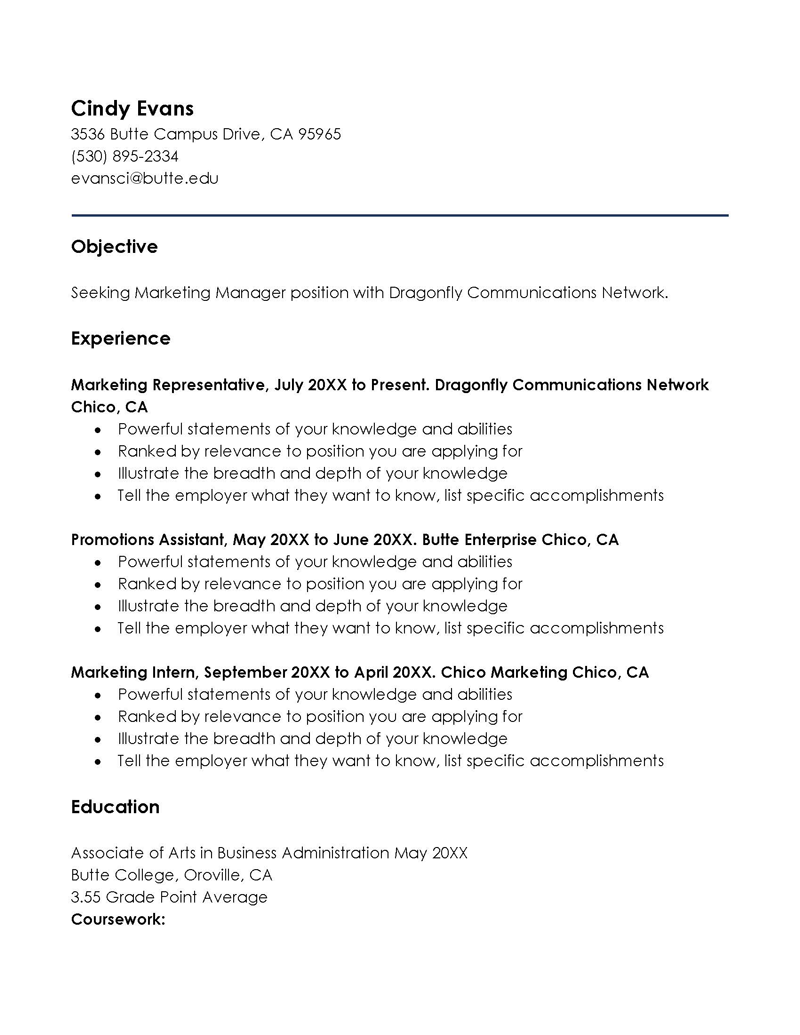
Pros and Cons of Using a Reverse Chronological Format Pros
Even though the reverse chronological resume format offers many benefits, this option has some downsides. Learning when to avoid using this option and when it will get the desired results is essential.
Here is what you need to know:
The pros include:
Provides a straightforward narrative of your career
This is one of the main benefits of using a reverse chronological format. By listing your work experience in reverse chronological order (i.e., starting with your most recent job and working backward), you create a clear and easy-to-follow narrative of your career progression over time. This can be particularly useful for employers who are looking for candidates with a specific level of experience or who want to see how your skills and responsibilities have evolved.
Conforms to expectations
Recruiters expect to see this kind of resume format, and they know what to look for and where to look. But, at the same time, it is a great option when applying to large organizations that use automated tracking systems for job applications or standardized application forms.
Emphasizes well-known companies
This resume format highlights the companies you worked for in the past. If you have worked for some of the most-established brands, this format can prevent that from going unnoticed by recruiters.
The cons include:
Shows the gaps in your work history
The reverse chronological format instantly shows if you have not worked for a year or two. In other words, recruiters can see that you have gaps in your career, which might be concerning for them. Also, it highlights the duration of employment at each job, making it easy for the employer to see how long you worked at each position. If you have had many short-term jobs, it may raise questions about your stability and job commitment.
Not suitable if you are switching careers
A chronological resume typically emphasizes your most recent work experience, which can be a disadvantage if you have not worked in a particular field for an extended period.
If you have marketing experience but your most recent marketing job was seven years ago, recruiters might not notice this on your resume or might not consider it relevant. This could potentially weaken your chances of being considered for a job in that field.
Not perfect for entry-level candidates
These kinds of resumes are designed to highlight your prior experience , but people who are new to the job market do not have any work experience, and as such, this format is not useful for them.
Since a reverse chronological resume is the most common format, having one ready is always a good idea. In addition, chances are high that your next job application will require this kind of resume. At the same time, it is important to keep your resume updated and incorporate any recent awards or achievements. Hopefully, this post has helped you understand how to create an effective document. Make sure to download our template so that you can easily create a perfect resume.
About This Article

Was this helpful?
Great! Tell us more about your experience
Not up to par help us fix it, keep reading.

Employment , Resumes
Babysitter resume samples (skills, objective, format & more).

20 Best Data Scientist Resume Examples (Formatting Guide)

12 Free Resume Templates for Data Entry Operators

16 Resume Examples for a College Student (How to Write)

How To Write Work Experience In Resume (Samples & Tips)

24 Quality Control Resume Examples (Free Templates)

Human Resource , Resumes
14 simple high school student resume examples.

12 Medical Student Resume Templates – Examples – Tips

The Right Way to Format Any Resume (Templates Included!)

36 Perfect Resume Summary Examples (How-to Guide)

20 Manager Resume Examples: Format, Skills, Templates
Thank you for your feedback.
Your Voice, Our Progress. Your feedback matters a lot to us.

How to Decide Whether to Use the Reverse Chronological Resume
In This Guide:
What is the reverse chronological resume format
Benefits of the reverse chronological resume
Who is the reverse chronological resume for
Is the reverse chronological resume format right for you
66 Reverse chronological resumes
Why is the reverse chronological resume format better
How to write a reverse chronological resume
What’s at stake when using a reverse chronological resume
Chronological or reverse chronological resumes
The truth about reverse chronological resumes
Reverse chronological vs functional vs combination format, key takeaways.

The reverse chronological resume is the most common resume format out there, but is it impactful?
Today’s hiring landscape requires you to not only provide recruiters with information but to package it in a way that they remember. Especially when there’s a tsunami of applicants arriving at their desks.
Everyone is reduced to a piece of paper when it comes to resumes, so how can you make yours as effective as possible?
See the benefits of the reverse-chronological resume and examples of how others have used it in their job application process below. Or explore our professionally designed chronological resume templates instead!

What is the reverse chronological resume format?
The reverse-chronological resume describes the most recent job first and moves backward in time for every subsequent position.
The format comes with the following general expectation of flow:
Resume header
- Personal summary
- Work experience
- Skills section
- Optional - any other relevant sections that make sense for the job you’re targeting. For example, projects, volunteering, or languages.
While this is the convention, it’s certainly not the law. You can keep the spirit of a reverse-chronological resume without sticking to a restricting structure. We’ll get into this further on in the article.
Read our full guide about resume sections to confidently optimize a stronger resume that’s more likely to attract job recruiters!
What are the benefits of using a reverse chronological resume?
Going with a reverse chronological resume format can really boost your job application. This style has some great benefits that help show off your career growth and achievements in the best way possible. Here’s what a reverse chronological resume will help you achieve:
Provide a clear narrative of your career
Inconsistencies inyour career history are one of the first red flags recruiters will notice. Especially since recruiters spend just 6 seconds on initial screenings, your resume can easily be overlooked.
The recruiter is interested in the story of your career — including what brought you to this current position. This can play into your culture fit and your impact on the team dynamics within the organization.
To illustrate this, let’s see what Jonathan, one of Enhancv’s customers, wrote on his resume.
- • Logged over 1,000 incoming and outgoing food donations into the inventory database within the Logistics department.
- • Collaborated with 10+ beneficiary centers to project demand and prepare outgoing food pallets.
- • Partnered with 15 local businesses to initiate food donations and maintained relationships with current donors.
- • Compiled and analyzed performance and workload data for 50+ research centers across the country.
- • Produced fiscal year retrospective reports on trends and analyses and quarterly reporting of key performance metrics.
- • Prepared and participated in 10+ briefings for senior leadership of the Agency on performance trends.
- • Developed content and compiled a weekly electronic report distributed to over 500 employees, detailing upcoming events, deadlines, vacancy opportunities, and employee spotlights.
- • Served as confidential assistant to the Director, trusted with sensitive information, and engaged in discussions to improve team performance, streamline processes, and enhance operational efficiency of administrative service delivery.
When Jonathan was getting his job at HEB (one of the largest grocery retailers in Texas), he used the reverse-chronological order with Enhancv’s resume builder to highlight his journey into operations from data analytics. Because of this, job recruiters were able to estimate his skill level and recognize his commitment to the area.
Line up with recruiters’ expectations
Sometimes the traditional route is best. This can come into play when applying to large organizations with standardized application forms or those who rely on Automated Tracking Systems (ATS).
With the reverse-chronological resume being the most common, it’s easily analyzed by the ATS and gives recruiters exactly what they’re looking for. They can directly identify your most recent job and quickly assess how that experience compares to what you’ll be doing.
As the saying goes, “You’re only as good as your last performance”.
Have big names play in your favor
One of the advantages of using this format is that it emphasizes the organizations you’ve worked at previously. If you’ve worked with some heavy hitters in your industry, this can create a great impression on the hiring managers and separate you from the crowd.
- • Helped establish the Disney Cruise Line brand leading up to and including the maiden voyage of the Disney Magic.
- • Worked in partnership with Disney alliance partners (Coca-Cola, General Motors, American Express, et al) to achieve synergy as an extension of other Disney brands.
- • Selected to serve with elite Event Services division to coordinate and execute the press event for the 25th Anniversary of Walt Disney World.
- • Honored with prestigious Partners in Excellence award, internal recognition for top 2% Cast Members (employees) - the highest recognition within the Walt Disney Company.
Who is the reverse chronological resume for?
There are 4 common cases when you’d need to provide a reverse chronological overview of your experience. It’s best for:
- Professionals with a consistent work history : If you have a stable career progression, the chronological resume format highlights it, showing potential employers your growth and reliability over time.
- Individuals advancing in their career : If you're aiming for a higher position, the reverse-chronological resume style emphasizes your most recent roles and accomplishments, proving you're ready for the next step.
- Job seekers in the same industry : If you're staying within your field, this chronological format makes it simple for employers to track your career development and relevant experience.
- Students and recent graduates : If you're fresh out of school, this format showcases your latest achievements and education, making it easy for employers to see your most relevant experiences first. (Yes, even your education section entries should be listed in reverse chronological order).
Is the reverse chronological resume format right for you?
Your best bet would be to craft a resume using one of the other two formats to make your employment gaps less obvious . For example, the hybrid resume allows you to highlight your skills rather than your career progression, providing a good workaround.
We recommend avoiding this format if you're in an entry-level role or have mainly temporary work experience.
Just remember, whichever format you choose, list your experience, internships, education, and achievements in reverse chronological order.
Reverse chronological resume samples for 66 job titles
Below is a comprehensive list of jobs where the reverse chronological resume can best fit a candidate’s substantial experience.
Here are some job roles where this format is particularly advantageous:
- Senior executive (CEO, CFO, COO) : For senior executives, a reverse chronological resume highlights an extensive career trajectory and leadership roles. It allows you to demonstrate your experience in managing companies, driving strategic initiatives, and leading large teams.
- Medical professional (doctor, surgeon, nurse) : Medical professionals benefit from the reverse chronological format as it details their clinical experience, residency, and fellowship training. It also emphasizes your professional development and the increasing responsibility you’ve taken on over time.
- Academic (professor, research scientist ): Academics and researchers often have a long history of positions, publications, and research projects. The reverse chronological resume allows you to showcase your educational background, academic appointments, and contributions to your field in a structured manner.
- Attorney (lawyer, legal counsel) : Lawyers and legal professionals can use this format to outline their careers in the legal field, including positions held at different law firms, types of cases handled, and any significant legal victories.
- Engineer (civil, mechanical, electrical) : You can benefit from this format as it highlights your technical experience, projects completed, and roles within various companies. It provides a clear timeline of your professional development, certifications, and advancements in your engineering career.
- Sales manager : Use a reverse chronological resume to demonstrate your sales achievements, leadership roles, and the progression of responsibilities. This format is ideal for showcasing a history of meeting or exceeding sales targets and managing sales teams.
- IT manager/director : IT professionals with extensive experience can use this format to highlight their roles in managing IT infrastructure and leading technology projects. It allows employers to see your growth and contributions to previous organizations.
- Marketing director : For this role, the reverse chronological resume helps to emphasize your experience in developing and executing marketing strategies, leading teams, and career growth within the marketing domain.
- Financial analyst : You can use this format to present your career progression, from entry-level analyst roles to senior positions.
- Operations manager: Operations managers benefit from a reverse chronological resume by detailing their roles in improving operational efficiency, managing logistics, and overseeing day-to-day operations. This format underscores your career development and achievements in optimizing business processes.
Here are the job titles by sector:
Accounting & finance
- Accountant Resume
- Financial Analyst Resume
- Auditor Resume
- Business Analyst Resume
- Business Development Resume
- Business Intelligence Resume
Creative
- Artist Resume
- Writer Resume
- Videographer
Data science
- Data Scientist Resume
- Data Architect Resume
- Data Engineer Resume
- Designer Resume
- UX Designer Resume
- App Designer Resume
Engineering
- Engineering Resume
- Mechanical Engineer Resume
- Industrial Engineer Resume
- Product Engineer
- Automotive Engineer Resume
Executive and management roles
- Executive Resume
- IT Director Resume
- Chief Marketing Officer Resume
Foodservice and hospitality
- Chef Resume
- Restaurant Operations Manager Resume
- Hospitality Manager Resume
- Food and Beverage Manager Resume
Government and federal agencies
- Military Resume
- Government Resume
- Federal Resume
Human resources
- HR Manager Resume
- Director of Operations Resume
- HR Business Partner Resume
Information technology
- Computer Science Resume
- Information Security Engineer Resume
- Software Engineer Resume
- Web Developer Resume
- Tech Resume
Law enforcement
- Police Officer Resume
- Law Enforcement Resume
- Lawyer Resume
- Attorney Resume
- Legal Assistant Resume
Manufacturing
- Procurement Manager Resume
- Supply Chain Manager Resume
- Marketing Director Resume
- Digital Marketing Manager Resume
- Brand Manager Resume
Nursing and healthcare
- Doctor Resume
- Nurse Resume
- Psychologist Resume
Project management
- Project Manager Resume
- Product Manager Resume
- Program Manager Resume
Sales and retail
- Sales Resume
- Sales Executive Resume
- Sales Engineer Resume
- Scientist Resume
- Researcher Resume
Teaching and education
- Teacher Resume
- Teacher Assistant Resume
- School Counselor Resume
Quality assurance
- Quality Assurance Engineer Resume
- Quality Assurance Analyst
- Test Engineer Resume
Why is the reverse chronological resume format better?
The reason is relevance. On your resume, you should always prioritize experiences and skills directly related to the job you're applying for. Your most recent work experience provides a better reflection of your current qualifications than a job you did 5 years ago. The same applies to your educational progression.
By placing your latest experience at the top, you direct hiring managers’ attention to your most relevant achievements first. This allows them to quickly assess how well you’ll perform in the prospective job. Plus, this format ensures that the most pertinent and updated information is highlighted, making it easier for employers to see your fit for the role.
Always tailor your resume to the job you’re applying for . Don’t list everything that comes to mind just to fill up space. Instead, select keywords from the job description and strategically incorporate them into your resume. This will help you pass the ATS screening and make it easier for recruiters to read through your document.
You’ve probably seen a resume in reverse chronological order before—this is the most common type of resume and it's all over the internet. However, we’re here to give you some quick tips on how to craft yours step by step, along with some insider guidelines on mistakes to avoid.
The reverse chronological resume template should have the following sequence:
The top sections on a reverse chronological resume
- A clear and informative header that doesn’t leave recruiters guessing who’s applying for what.
- A compelling resume summary or objective that gives hiring managers an overview of your professional expertise and qualifications.
- A detailed and targeted resume experience section showing your fit for the role.
- A concise education section listing your most relevant academic accomplishments and certifications.
- A skills section showcasing the tools and techniques you’re most experienced in.
- An optional additional section with your top achievements, projects, or publications (whichever is most relevant to the job you’re targeting).
You may wonder what makes these sections so typical of the reverse chronological format. It’s the visual hierarchy they create on the resume. A clear and predictable organization makes it easier for recruiters to read and assess your qualifications, making them more relaxed and engaged with your resume.
Let’s tackle these sections one by one.
The resume header is the section at the top of your resume and serves as the first point of contact for recruiters. It's often personalized with contrasting colors and a larger font size to attract attention. It should contain the following details:
- Contact information : State your name, job title, and location. Ensure your contact information is professional, including an email address.
- Links : Include a link to your professional portfolio or your LinkedIn profile .
- Resume photo : Generally, it’s best to omit photos to maintain focus on your qualifications and avoid potential biases.
Mistakes to avoid
Not making your name searchable. To make it easier for recruiters to find your resume in a sea of candidates, ensure your name matches your LinkedIn profile, the email address, and the file name.
Resume profile
A resume profile is a section that includes a brief overview of your previous experience, skills, and future goals related to a specific job opening. We normally distinguish between two types—a career summary and an objective statement. Here’s how to write yours:
- A short paragraph : Depending on your level of experience, write 3-5 sentences that highlight your best qualities, skills, and career goals. (Learn more about objective statements and how they differ from a resume summary).
- Choice of words : Use strong adjectives to describe yourself and start each sentence with a dynamic verb. Avoid writing in the first-person perspective .
- Finish up strong : Use the final sentence to reinforce your message. Make recruiters want to learn more about you.
Writing a resume summary or objective that’s too vague or generic. Ensure your profile is specific, tailored to the job you’re applying for, and highlights your unique qualifications and career goals.
Resume experience section
Your work history section determines the format of your resume. Senior candidates can benefit greatly from listing experience in reverse chronological order, while entry-level individuals should go for a hybrid or functional resume.
This is how your experience entries should be listed:
- Job title and company : Clearly state your most recent position and the company you worked for.
- Dates of employment : Include the month and year you started and ended each job. You also have the option of ticking “Ongoing” on the Enhancv’s resume builder.
- Job description : Optionally, add a short description of your role in the company , especially if it was a startup or an NGO—recruiters will need more context about it.
- Bullet points : Write 3-5 bullet points about your main tasks, duties, and contributions. Whenever possible, include numbers or statistics to illustrate your impact (e.g., increased sales by 20%, managed a team of 10).
- Relevant skills : Mention the skills you developed or used in each position that are pertinent to the job you’re applying for.
- Action verbs : Start each bullet entry with an action verb to showcase your initiative.
An experience section that doesn’t provide quantifiable results. Don’t just list job duties—include concrete numbers to make your impact tangible.
If you need a more detailed breakdown of how to build your experience section, dive into our article: How to List Work Experience on Your Resume—A Guide with Examples .
Resume education
Your education section also needs to follow a specific hierarchy to be more readable. See the steps below:
- Degree : Start with the highest degree you’ve obtained (e.g., Bachelor’s, Master’s, Ph.D.) and your major or field of study .
- University or college : Include the name of the institution where you earned your degree.
- Location : Mention the city and state (or country, if international) of the institution.
- Graduation date : Provide the month and year of your graduation. If you’re still studying, indicate your expected graduation date .
- Honors and awards : If applicable, list any honors, awards, or distinctions you received (e.g., summa cum laude , Dean’s List ). If you’re fresh out of school, your GPA might come in handy, but only if it’s above 3.5.
- Relevant coursework : Optionally, include coursework relevant to the job you’re applying for, especially if you’re a recent graduate or changing careers .
Omitting important details. Make sure you include all critical information to ensure clarity and completeness.
Resume skills
Resume skills help potential employers identify whether you would be a good fit for the role. Consider the whole process from the recruiter's point of view. They’ll either briefly skim the document to identify relevant skills or work with ATS to identify them. Use the tips below to make your skills section count:
- Hard skills: If your job relies on software or specific tools, list your technical skills in a dedicated section on your resume.
- Soft skills : Unlike hard skills , which can be validated by certifications, soft skills are harder to prove. Integrate them into other resume sections and provide concrete examples of how you’ve demonstrated these skills.
- Relevance : Always prioritize listing skills that are specifically required in the job description.
Including irrelevant or generic skills that don’t align with the job you’re applying for. Always tailor your skills to match the job description, ensuring they’re specific and relevant to the position. This will make your resume more targeted and appealing to employers.
Additional sections
Depending on the job you’re applying for, inserting more sections into your resume can add value to your application.
- Space : Only add extra sections if you have enough space. A one-page resume is usually sufficient unless you have over 10 years of experience or are in a C-level position.
- Tailored approach : Choose sections based on the job requirements. For example, if you lack direct experience , you might include a “Hobbies & Interests” section to show how your leisure activities relate to the role.
- Common additional sections : Certifications , languages , and projects are often even mandatory for certain jobs. The key here is to include those that will strengthen your application the most.
Overloading with information and irrelevance. Providing too much detail can make the resume poorly targeted, lengthy, and difficult to read. Aim for conciseness and relevance.
Reverse chronological resume example — SEO Content Specialist

Reverse chronological resume example — IT Specialist
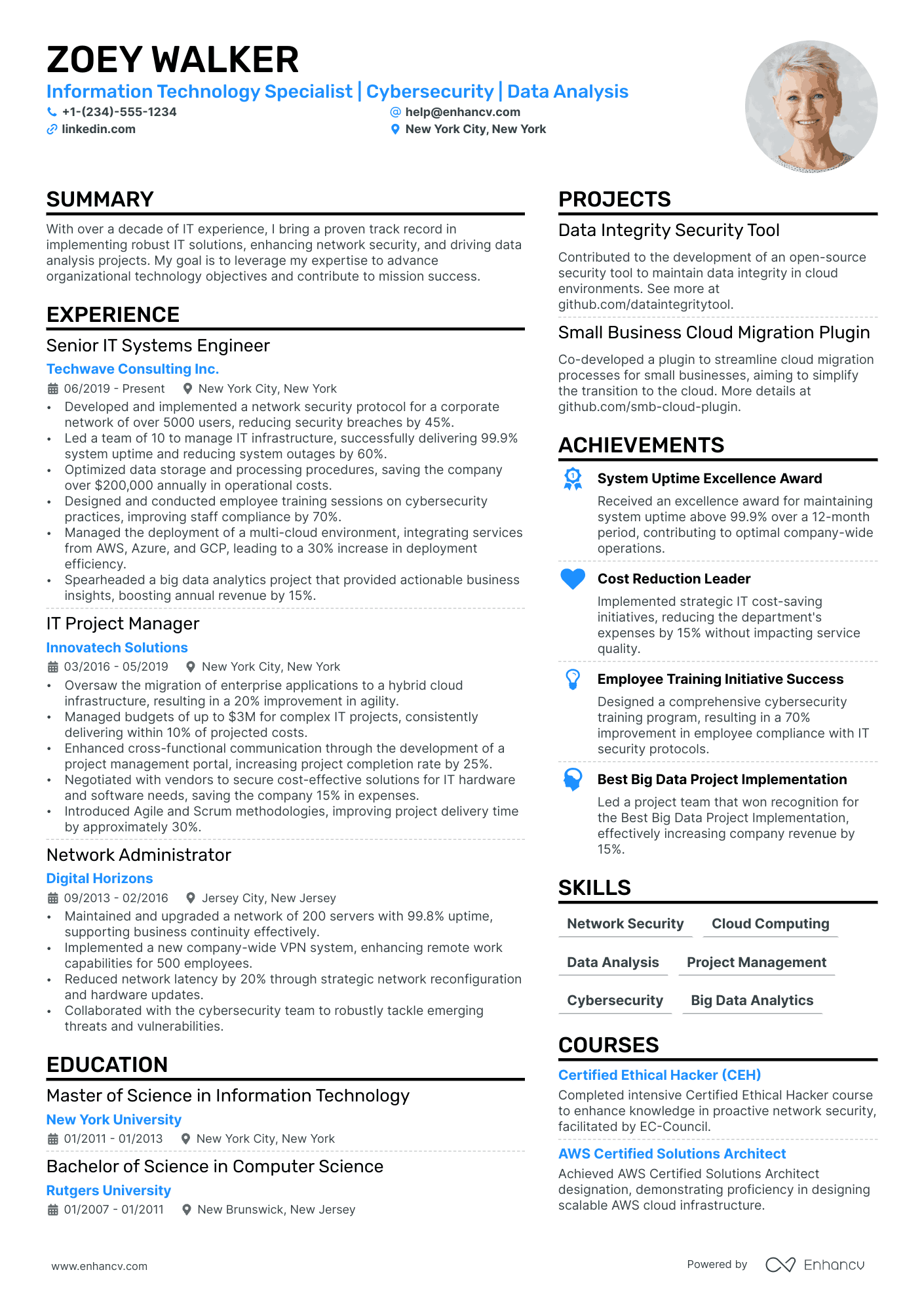
Reverse chronological resume example — Accountant

Reverse chronological resume example — Project Manager
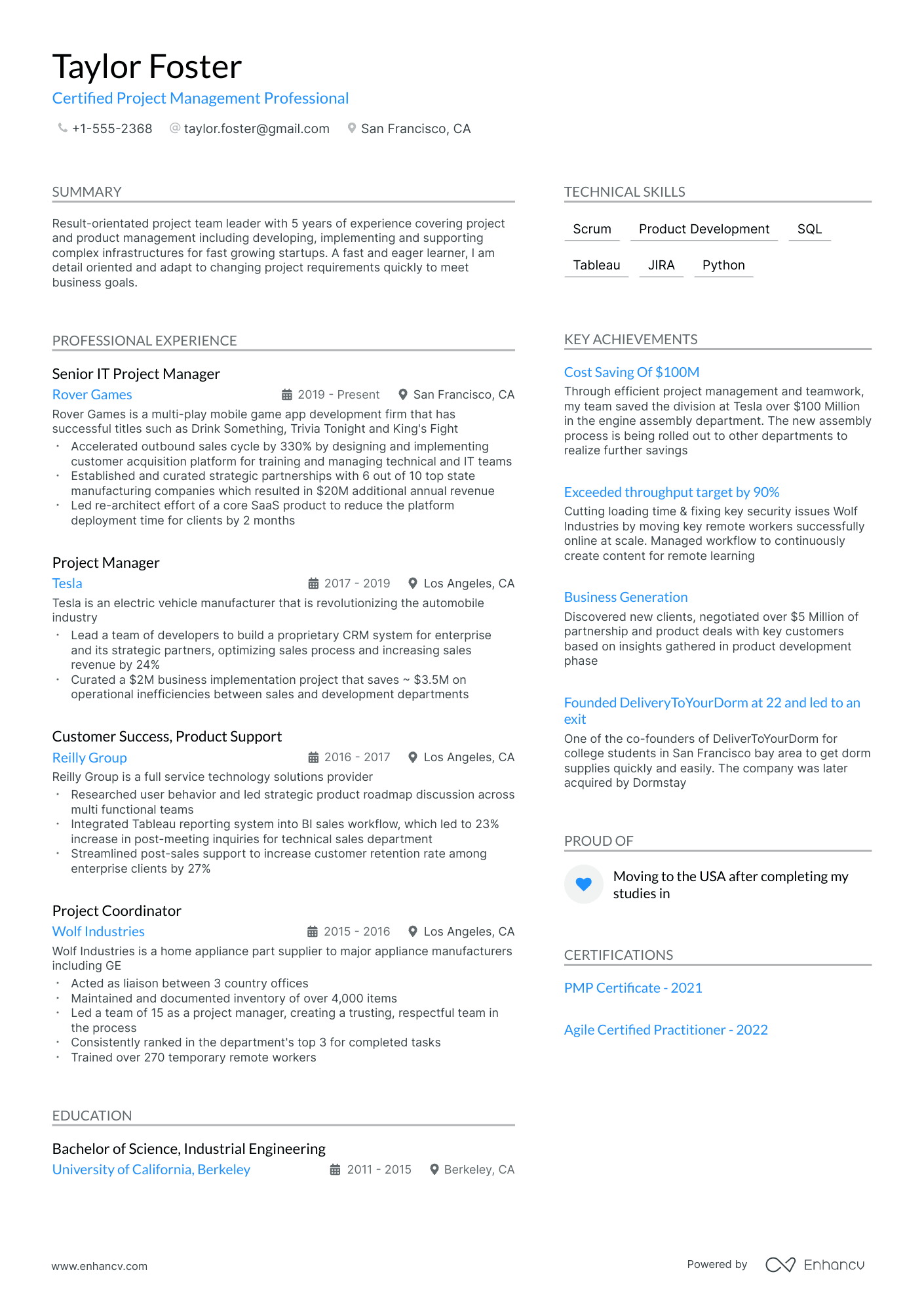
Reverse chronological resume example — Product Manager
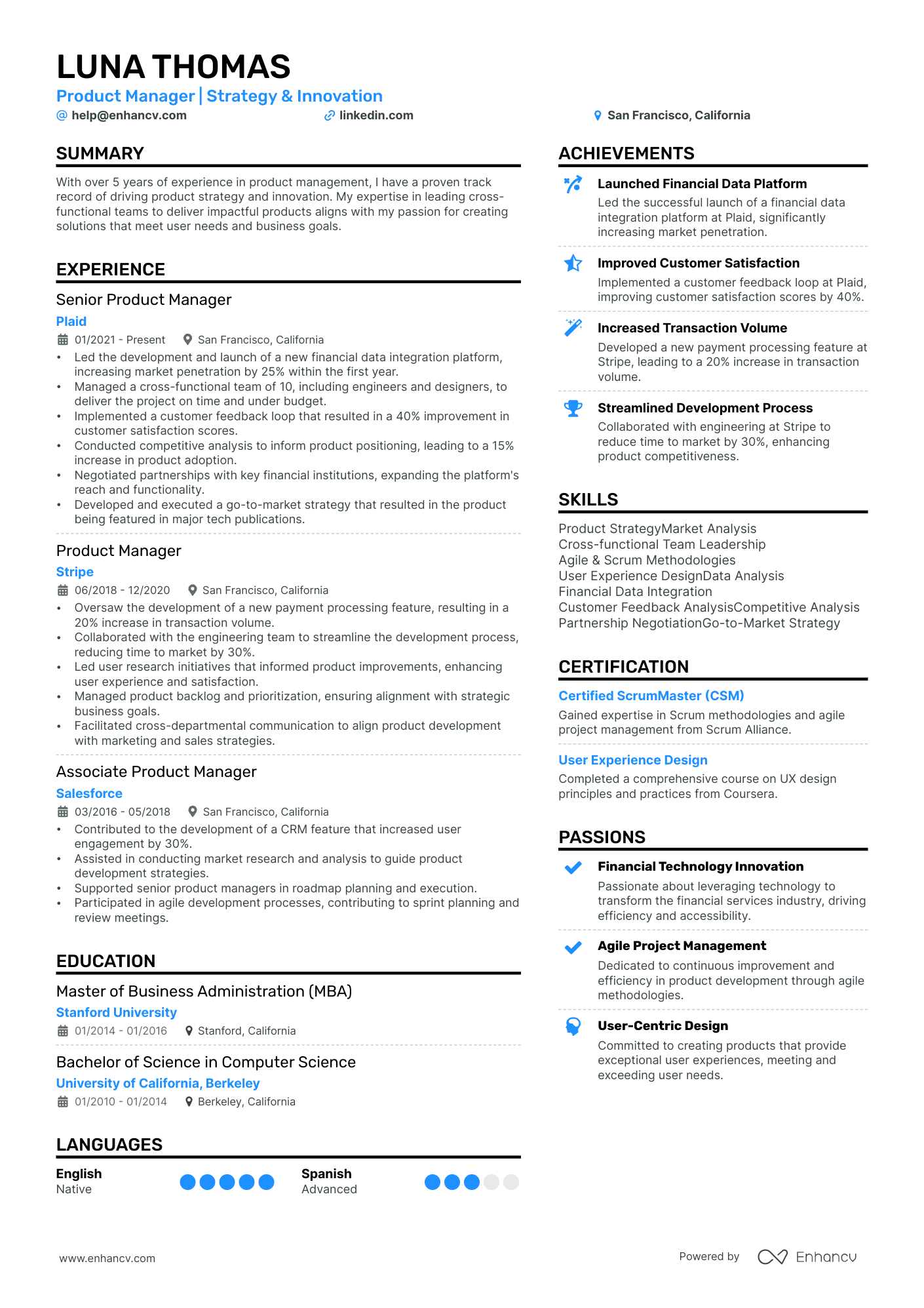
Reverse chronological resume example — Executives
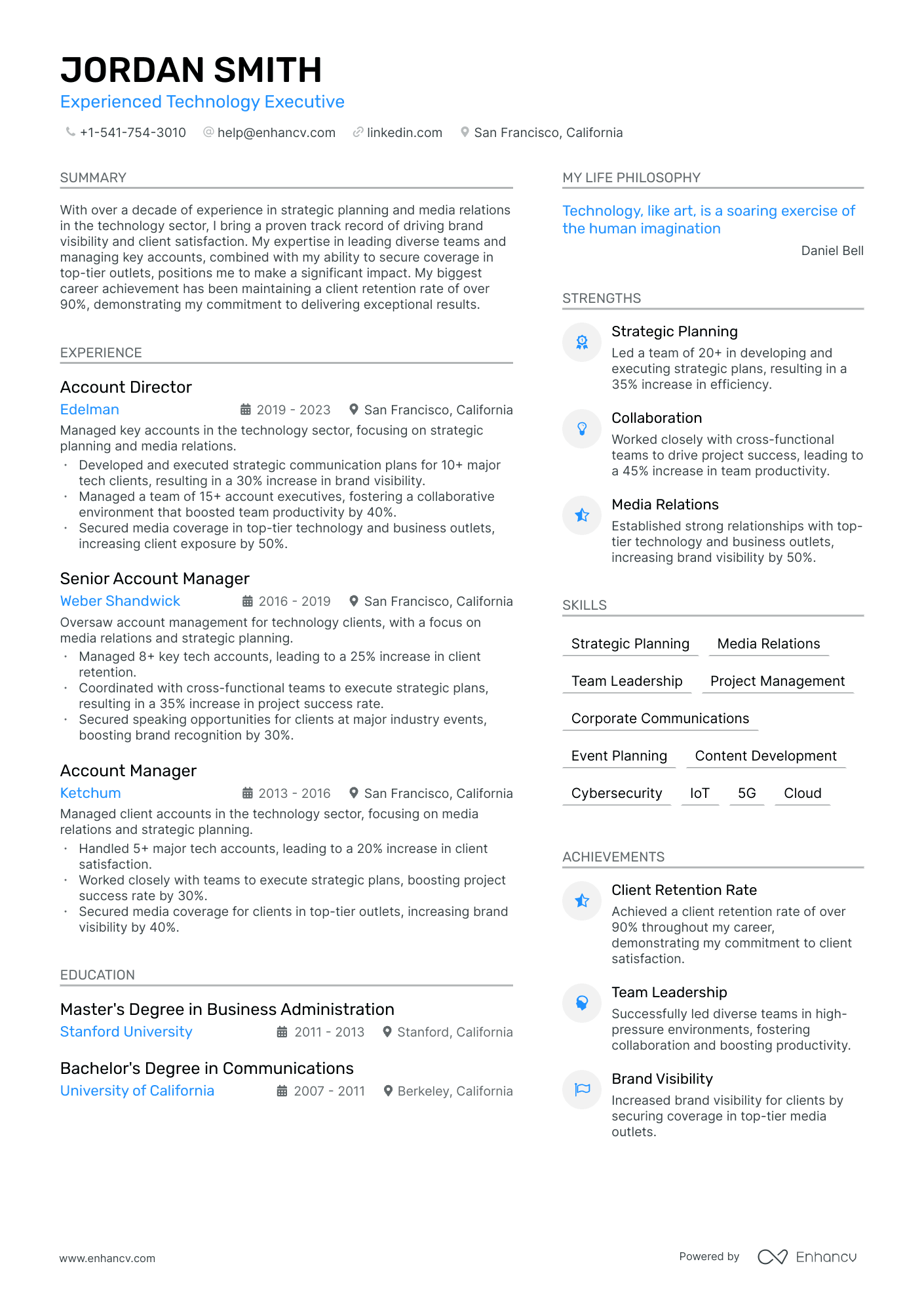
Reverse chronological resume example — Doctor
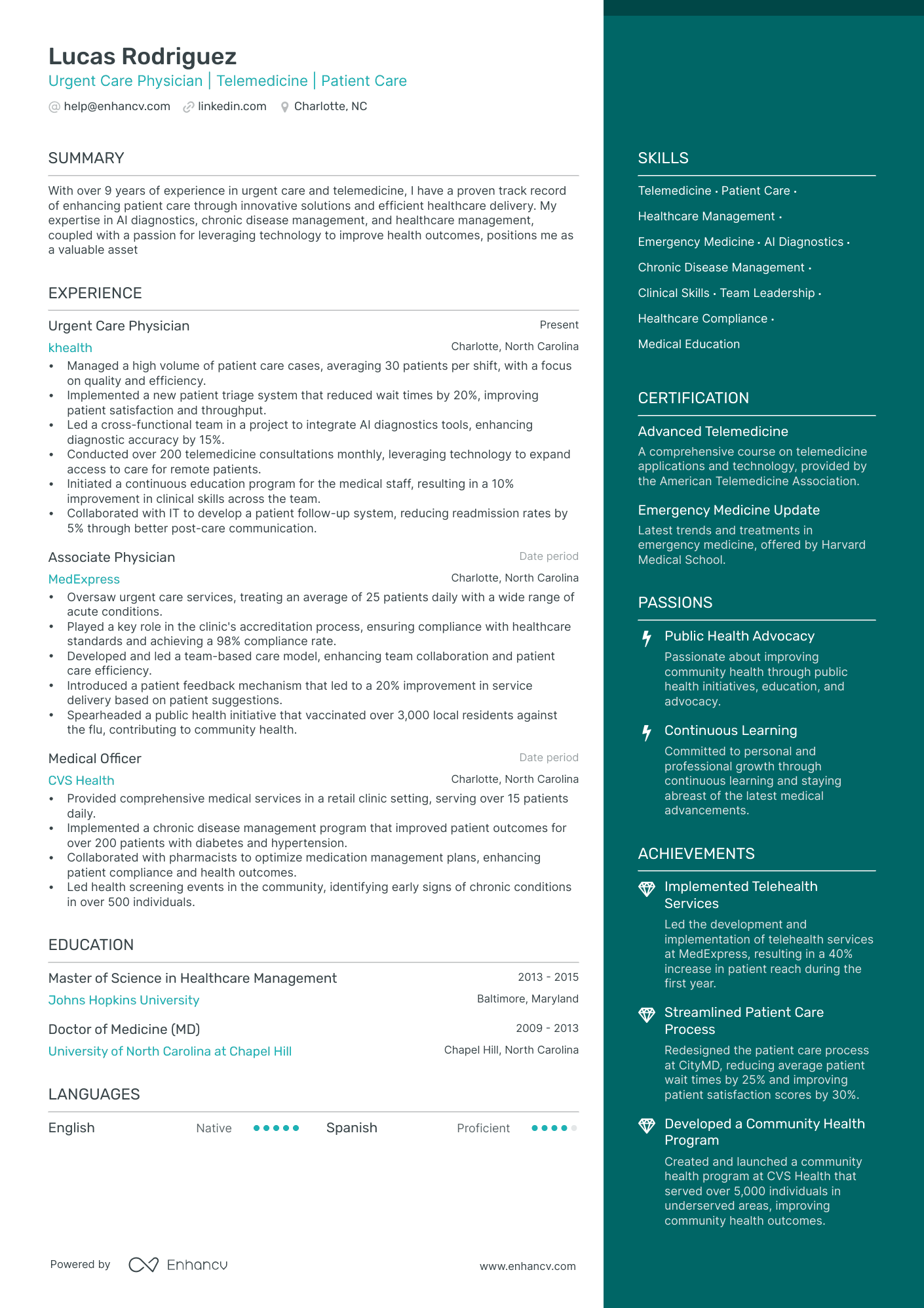
Reverse chronological resume example — Financial Analyst

Reverse chronological resume template
[Your Name]
[Your City, State, ZIP] | [Your Phone Number] | [Your Email Address] [LinkedIn Profile] | [Professional Website or Portfolio]
Professional summary
A concise summary highlighting your key qualifications, skills, and career goals. Typically 3-4 sentences.
Professional experience
[Most recent job title] [Company Name], [City, State] [Month/Year] – [Month/Year]
- Optional description.
- [Action verb] [your duty and/or accomplishment] [quantified results].
[Previous job title] [Company Name], [City, State] [Month/Year] – [Month/Year]
[Earlier job title] [Company Name], [City, State] [Month/Year] – [Month/Year]
[Degree Earned] [University Name], [City, State] [Month/Year] – [Month/Year]
- Relevant coursework: [Course Names]
- Honors and awards: [Any relevant honors or awards]
Certifications
- [Certification Name], [Issuing Organization], [Month/Year]
- Technical skills: List relevant technical skills
- Hard skills: List role-specific practical skills
- Languages : List any languages spoken, if applicable.
- Professional affiliations
[Organization Name], Member since [Year]
- Projects (if applicable)
[Project title] [City, State] [Month/Year] – [Month/Year]
Description of responsibilities and achievements.
What’s at stake when using a reverse chronological resume?
Here are some of the considerations that pop into mind when creating a reverse chronological resume.
Gaps in your resume become more noticeable
“Do they still possess the same skills they had X years ago?” “Will they be able to adapt to the current market?”
These are just two of many possible questions the recruiter might not even spend the time to try and get an answer.
A chronological timeline will make the gaps in your career more apparent. If it's been a couple of years since your most recent job, that can be a red flag for the recruiter.
(Tip: One way to overcome this difficulty is to describe other projects or skills you’ve developed during the break.)
Harder to navigate through different sectors
Let’s say you have experience in both music and marketing. You’ve spent the last five years pursuing jobs in music, but now you’re looking for a new job in marketing.
In this case, it might make sense to use a reverse-chronological resume format. However, sticking to this structure could make your experience seem irrelevant. This makes it even harder for you, especially when you’re trying to move through the different areas that you’re skilled in.
(Tip: When building your resume, only select experience that’s relevant to the position you’re applying for).
Not optimal for first-time job seekers
With prior experience being the crux of this resume format, it’s going to be difficult to write your first resume in reverse chronological order. For this reason, this format is not suitable for those entering the job market or applying for volunteer positions for the first time.
(Tip: Go for a skills-based resume and make your strengths and talents shine through).
Chronological or reverse chronological resumes?
Chronological and reverse chronological resumes are often used interchangeably as they refer to the same format. They both mean listing your work experience starting from the most recent position and moving backward in time.
However, we use the more precise convention—reverse chronological—to avoid confusion.
This is a traditional format and it’s great for organizing your experience. Still, keep in mind that reverse chronological resumes are far from one-size-fits-all.
In reality, your resume should be tailored to the position you’re applying for . That’s what we call a targeted resume . This may mean starting with a less recent job first as long as it’s more pertinent to the prospective role.
With Enhancv’s resume builder, you can describe your previous experience in modular segments that can be moved as pieces to any place on your resume. This makes positioning easily streamlined, so you don’t have to worry too much.
Overall, you’ll benefit from organizing your resume by relevance and impact, not by date.
Besides the reverse chronological resume, there are two other formats that suit different needs.
- The functional (skills-based) resume focuses on skills and experiences rather than a chronological work history, making it ideal for career changers or those with gaps in employment. You can put your skills section at the top, just below the resume summary, and provide relevant information about your strengths and abilities.
- The combination (or hybrid) resume blends elements of both the reverse chronological and the functional formats, highlighting skills and achievements at the top, followed by a detailed work history. This format is great for showcasing relevant skills while also providing a clear employment timeline. It’s best for roles in project management, marketing, graphic design, and software development where a mix of technical and interpersonal skills is essential.
Take a look at the table below to see how the three formats compare to each other.

Choosing the right resume format can make a huge difference in catching a recruiter’s eye. The reverse chronological resume is a popular choice for a reason, offering a clear and organized way to present your career history.
- Tells your career story : This format provides a straightforward timeline of your professional journey, making it easy for recruiters to see your growth and development.
- Recruiter-friendly : It’s a format that recruiters know well and can quickly scan, especially with the help of ATS.
- Showcases top employers : If you’ve worked for some big names, this format highlights those prestigious employers, helping you stand out.
- Perfect for stable careers : If you have a consistent work history, this format shows off your reliability and continuous growth.
- Great for moving up : It’s ideal for those looking to advance in their careers, as it emphasizes your most recent roles and achievements.
- Best for staying in the same field : If you’re sticking within your industry, this format makes it easy for employers to track your relevant experience.
- Good for new graduates : Even if you’re just out of school, this format can showcase your latest achievements and education, putting your most relevant qualifications front and center.

- Resume Guides
What to Include in Your Cover Letter
A breakdown of a successful one page resume – and how to write yours, 12 great jobs for stay at home parents, how to answer the “what makes you unique” interview question (with tips and examples), here's what you need to know before your next job interview, which resume font to use for making an outstanding resume.
- Create Resume
- Terms of Service
- Privacy Policy
- Cookie Preferences
- Resume Examples
- Resume Templates
- AI Resume Builder
- Resume Summary Generator
- Resume Formats
- Resume Checker
- Resume Skills
- How to Write a Resume
- Modern Resume Templates
- Simple Resume Templates
- Cover Letter Builder
- Cover Letter Examples
- Cover Letter Templates
- Cover Letter Formats
- How to Write a Cover Letter
- Cover Letter Guides
- Job Interview Guides
- Job Interview Questions
- Career Resources
- Meet our customers
- Career resources
- English (UK)
- French (FR)
- German (DE)
- Spanish (ES)
- Swedish (SE)
© 2024 . All rights reserved.
Made with love by people who care.
Why the Reverse Chronological Resume Is the Most Popular Format
The reverse chronological resume format is widely used by job seekers today for a reason. As a whole, it’s a strong approach for professionals at all levels. But what’s more important than the priority of the date...

The reverse chronological resume format, meaning that your most recent or current job is listed first, followed by previous positions in descending order of recency, is widely used by job seekers today for a reason.
As a whole, it’s a strong approach for professionals at all levels.
But what’s more important than the priority of dates is whether or not it’s most impactful for the hiring manager.
If you’d like to learn more about how this formatting leads to candidate success and how you can use this concept to increase your hiring chances, keep reading on!
“I used Rezi to make my resume look more professional. I had applied to a handful of jobs before using Rezi, but once I signed up and revamped what I had, I got call backs from almost all my applications” - Samantha W.
Explore Rezi 🔥 Comes with 5,000 AI Credits, and is free forever, no credit card required.
What is a Reverse Chronological Resume?
The reverse chronological order is a resume format that lists your work experience from the most recent job position and qualifications going back to the oldest position.
This format is widely accepted and preferred by many employers because it provides a clear and easy-to-follow timeline of your work history. It also shows higher relevance and contextuality, making it more compelling and leaving a more profound effect on the hiring manager.
Why It’s The Most Popular Resume Format
It’s a modern format and common approach used by job seekers when making an application.
Unlike listing in chronological order, it highlights the most recent and relevant details first.
It also reveals no gaps in your employment history as it shows a consistent timeline of your career. Meaning, employers can easily see your corporate progression and professional development.
Since it’s highly contextual to the job you’re applying for, it makes your application more impactful for recruiters.
Alternative Resume Formats
Depending on your circumstances, one of these 3 alternative resume formats could be the better option.
We’ll go through each of these below and who they’re best suited for:
- Chronological resume: effective for seasoned professionals since it highlights your years of experience in the workforce.
- Skills-based resume: useful for candidates with little to no work experience as it highlights your skills as opposed to your work experience.
- Hybrid resume: best for applicants who have at least 2 years of experience, highlighting both your skills and experience.
When to Use a Reverse Chronological Resume
All job seekers should aim to create a one-page reverse chronological resume as it showcases a stable record of your professional background. It’s good practice for providing clarity and making relevance and quality a priority.
The most relevant and important things should be shown first if you want to make a what to put on a resume .
But, there are some exceptions where you should reconsider using this format:
- You have gaps in your career history, e.g. you’ve worked at multiple jobs and companies in a short period of time.
- Employability issues, e.g. you haven’t been employed for the past year or two.
- If you have no work experience , it’s not the best approach since it highlights your work history.
In some of these cases, the skills-based format or hybrid resume would be the better option.
How to List Sections in Reverse Chronological Order
We’ll cover how the how to write a resume should be structured when creating a reverse chronological resume. Later, we’ve also included and analyzed proven examples that have got candidates interviewed at even the most competitive companies.
Despite how much experience you have as a professional, it works for almost all candidates.
1. Professional Work Experience
The first job title to mention should be the most recent position you’ve worked in.
What’s more important than the what to write in a resume for work experience and jobs you’ve had is its relevance. So, take into account if it’s related or helpful in any way, shape, or form to your prospective employer.
When describing your experience, the key details should be written down first. That includes information such as:
- Duties and responsibilities
- The impact you’ve made
- Accomplishments
Here’s an example below:

2. Education Section
As you’re listing your qualifications, start with the latest one you’ve achieved.
Then, go backward by writing down the awards you’ve achieved before that. This makes the date of your achievements clear and it brings attention to your formal knowledge in specific areas.
Here’s an example of this:

3. Additional Sections
Repeat the process from the previous steps but for your other resume sections.
By using this principle throughout your application, the reader will immediately notice that you’re up to date. This makes it easy to review and identify your strengths since you’re showing what’s most related to the job position you’re applying for.
Here’s an example from the certifications section:

Expert Reverse Chronological Resume Examples
One aspect that stays the same is that the most important details are mentioned first, so stick to your strengths. This holds true for all types of resumes.
If you're unsure of how to update resume , you may find it helpful to refer to some of the guides and expert resume examples we have available. These can provide valuable tips and guidance on how to craft an effective and compelling resume.
Blogger Resume

The work experience section is thorough and detailed when providing a description of previous responsibilities. But, it’s mostly in-depth with the recent job position as opposed to their first job position.
From this progression, it’s clear the candidate has developed their skills throughout their professional experiences.
Quality Engineer Resume

The employment history and engineering specializations section are reverse chronological. This allows the employer to notice their areas of expertise and how well-informed they are in certain fields.
Nurse Resume

The first job title listed is often the most detailed part of the section because they’re more relevant.
When it comes to the education section, they’ve made it simple for the hiring manager to see they’re updated with the formal knowledge required. It’s easy to notice this, as well as their other qualifications that have been written.
Reconsidering the Reverse Chronological Approach
It’s acceptable to reconsider elements of the reverse chronological format as long as it makes sense.
The importance of the information provided is a bigger factor than the dates themselves.
Here’s an example from the creative producer template that got the candidate an interview with Tesla:

From the sample above, notice that the section isn’t entirely in reverse chronological order.
The user emphasizes a significant project and ensures the recruiter sees this first, i.e. being a director & editor at Apple. This portrays a stronger impression at first glance and is more likely to grab the reader’s attention.
The Best Resume Format
Highlighting your career progress and professional strengths is easier with a reverse chronological resume. Plus, it’s flexible and works for almost all candidates. It’s no surprise why it’s the most popular resume format.
Above all, it emphasizes consistency and relevance.
But, the best approach depends on the context of your career timeline.
When you have gaps in your work history, consider using the hybrid or skills-based resume format.
Explore Rezi 🔥 Comes with 5,000 AI Credits, and is free forever, no credit card required.

Astley Cervania
Astley Cervania is a career writer and editor who has helped hundreds of thousands of job seekers build resumes and cover letters that land interviews. He is a Rezi-acknowledged expert in the field of career advice and has been delivering job success insights for 4+ years, helping readers translate their work background into a compelling job application.
- AU NZ SG --> HK CN
- Search jobs
- Contracting FAQs
- Web timesheets and resources
- Job interviews
- Psychometric testing
- Leadership development resources
- Insights – The blog
- Hudson Career
- Temporary Staffing
- Accounting & Finance
- Accounting Support
- Engineering
- Executive and Leadership
- Human Resources
- Marketing & Communications
- Program & Policy
- Project Management
- Property & Construction
- Risk & Compliance
- Supply Chain Procurement
- Technology & IT
- Volume Recruitment Services
- Graduate Recruitment Services
- Frontline Recruitment Services
- Psychometric Assessments
- Scaleup by Hudson Blog
- State of the Market Q2 2024
- Outplacement & redeployment
- Career transition
- Navigate change
- Realign capability
- Mobilise careers
- Coaching and leadership development
- Hire Now, Pay Later Solution
- flexhive – temporary staffing solutions
- Hudson Executive – Leadership recruitment
- Hellomonday – Leadership development and coaching
- Hudson Technology and Projects for tech recruitment
- Jobaccelerator – Career transition and outplacement
- Sapia – AI Smart Chat Interviewing
- scaleup – volume and graduate recruitment
- About the Hudson group
Resumes & cover letters: Reverse chronological resume example

The reverse chronological resume is the most common and traditional type of resume. With this resume format, you list your relevant work experience in reverse chronological order, beginning with your most recent position and proceeding backwards.
To help you write your reverse chronological resume, we have created this free resume example for a senior finance professional.














IMAGES
VIDEO
COMMENTS
Head straight to our articles: Blank Resume Templates: 15+ Best Blank Resume Forms to Fill In Now and Word Resume Templates. 5. Chronological Resume Examples for 30+ Professions. Here's a list of reverse-chronological resume examples for some of the most popular jobs in 10 different industries: Administrative Jobs. Administrative Assistant Resume
Reverse Chronological Resume Templates. The most commonly used resume format is a reverse-chronological one as it shows hiring managers how you progressed throughout your career. Get started with your resume: Create your resume. Top companies have hired candidates with our templates. Try this template.
Remember these 5 key takeaways when writing a reverse chronological resume: The work experience section is the most important in this format. Focus a good amount of time on tailoring this section for the job you are applying to. Always use a professional email. Your email is one of the first things employers see.
So when you list your achievements under your experience, use strong verbs that can paint a picture of who you are and what you can do. #5. Pharmacist Chronological Resume. With plenty of attributes up their sleeve, the chronological format is the perfect choice for a pharmacist's resume . #6.
Chronological Resume Template, Examples, and Format. ... A reverse-chronological order resume is a resume format that lists your work experiences in reverse-chronological order, starting with the most recent position at the top and moving backward. ... The Best Resume Builders for 2024: Top 11 Online Resume Builder Websites . Conrad Benz ...
Hit the ground running with an official Teal resume template designed with best practices. Resume Synonyms. Use our library of 600+ synonyms to find the perfect words for your next resume. ... Professionally structured reverse-chronological resume templates to present your career progression cohesively and impressively. All Templates ...
Here are tips to make the most of your professional experience in a resume: Start with the most recent position at the top and follow it up with the previous one. After all, you're following a reverse chronological order. Indicate the dates worked, the company's name, and the job title for each position listed.
Tips for building the best chronological resume template. Let's create your perfect chronological resume by following the best practices. Design. The reverse-chronological format resume template can be applied to any design - modern or traditional. It only depends on your professional field and the type of company you are applying to.
A reverse chronological resume is a resume that organizes the work experience section in reverse chronological format. That means it lists your most recent work experience first—then works backwards, in the same order, through your work history. If this sounds like the standard approach to writing a resume, that's because it is!
The chronological resume is a format that focuses on the employment history section where work experience is listed. The main idea is that you start with your most recent or current position and work backward through all your relevant experience of the past 10 years. NOTE: This structure is sometimes called the "reverse-chronological resume ...
Use standard section headings. Use section headings such as "work experience," "education" and "skills" to make it easy for the ATS to identify each section clearly. 4. Add optional sections. Optional sections can enhance your chronological resume in several ways, including: Magnifying certain skills.
A chronological resume is a resume format that lists your professional experience in reverse-chronological order, beginning with your most recent position and continuing in descending order. ... Related: How To Choose the Best Resume Template for the Job You Want. Show Transcript. Video: Resume Tips To Get Noticed Learn five tips to improve ...
A reverse chronological format displays your academic and professional experiences in reverse-chronological order. It indicates that the document lists all of your previous jobs in chronological order, beginning with the most recent one you held. The last entry on the list will be your first job. This format has become very popular and is the ...
Demonstrates stability. The reverse chronological resume can highlight consistent employment and upward career movement, qualities highly valued by employers. For instance, you can demonstrate a steady climb within a single company or industry—whether it was a corporate ladder or not— indicating loyalty and commitment.
You can use the following steps to write a comprehensive reverse-chronological CV: 1. Start with a header. A header helps introduce you to hiring managers, and you can center this section in the middle of your document. It includes your full name, followed by your current phone number, email address and location.
2. Chronological (Reverse-Chronological) Resume Format. Pros: Highlights professional experience and accomplishments. Easier to scan by ATS. Shows work history that is preferred and often required by employers. Cons: Requires strict and consistent formatting. Reveals employment gaps or frequent job-hopping.
The Best Chronological Resume Templates You Can Try Right Now. ... This reverse chronological resume template offers a clean single-column resume layout and a sophisticated logo in the corner. The smart use of whitespace makes this template remarkably easy on the eyes. 6. Concept
The reverse-chronological resume describes the most recent job first and moves backward in time for every subsequent position. The format comes with the following general expectation of flow: Resume header. Personal summary. Work experience.
Below you will find an example of a resume written in the reverse chronological resume format. This is the most widely used resume format. In this example the resume starts out with job title headlines (Sales Management) to quickly allow the reader to identify the job seeker's profession. The job title headlines are followed by a list of ...
Chronological resumes follow the same standard layout: 1. Craft a strong summary statement. The summary statement should concisely summarize your professional experience, skills and accomplishments. Here you should underline the key points in your work history and focus on your most relevant achievements.
1. List your contact details. Begin a reversed-chronological application by listing your contact details at the top of your document. Start by writing your full name in a bold and bigger font size than the rest of the text on your resume. Making your name the largest feature on your document can help hiring managers remember your application.
The reverse chronological order is a resume format that lists your work experience from the most recent job position and qualifications going back to the oldest position. This format is widely accepted and preferred by many employers because it provides a clear and easy-to-follow timeline of your work history. It also shows higher relevance and ...
The reverse chronological resume is the most common and traditional type of resume. With this resume format, you list your relevant work experience in reverse chronological order, beginning with your most recent position and proceeding backwards. To help you write your reverse chronological resume, we have created this free resume…
4. Add clickable links (for on-screen use) If you are sending your resume as a PDF, you have the opportunity to include hyperlinks. For example, you might choose to link out to your professional portfolio or your LinkedIn profile.. You can include these links as part of your resume header alongside your contact details. That way, should a recruiter want to learn more about you, they can with a ...
Hit the ground running with an official Teal resume template designed with best practices. Resume Synonyms. Use our library of 600+ synonyms to find the perfect words for your next resume. ... In a separate internship section, you can list all of your internship experiences in reverse-chronological order with plenty of detail, while putting ...
Select a resume format that best suits your background and the job you are applying for. ... List your educational background in reverse chronological order, starting with your most recent degree or current enrollment. ... Resume templates provide the framework for your resume and can help you write a professional-quality resume quickly. ...